Royal Birkdale Hole by Hole
This is my fifth hole by hole post from our fall 2024 trip to England’s Golf Coast organized by Platinum Golf Scotland. Yesterday we played what has been my favourite course so far, Formby,which has a completely different look than most links courses. Today we will tackle our third Open venue, Royal Birkdale which has played host to the event ten times from 1954 to 2017 and will once again host it in 2026. The caddies at the four previous courses have all unanimously agreed that Royal Birkdale is the most interesting of the three venues that regularly host the Open in northwest England. So please join our group as we play our final links course on this trip before heading to The Belfry for the conclusion.
History of Royal Birkdale
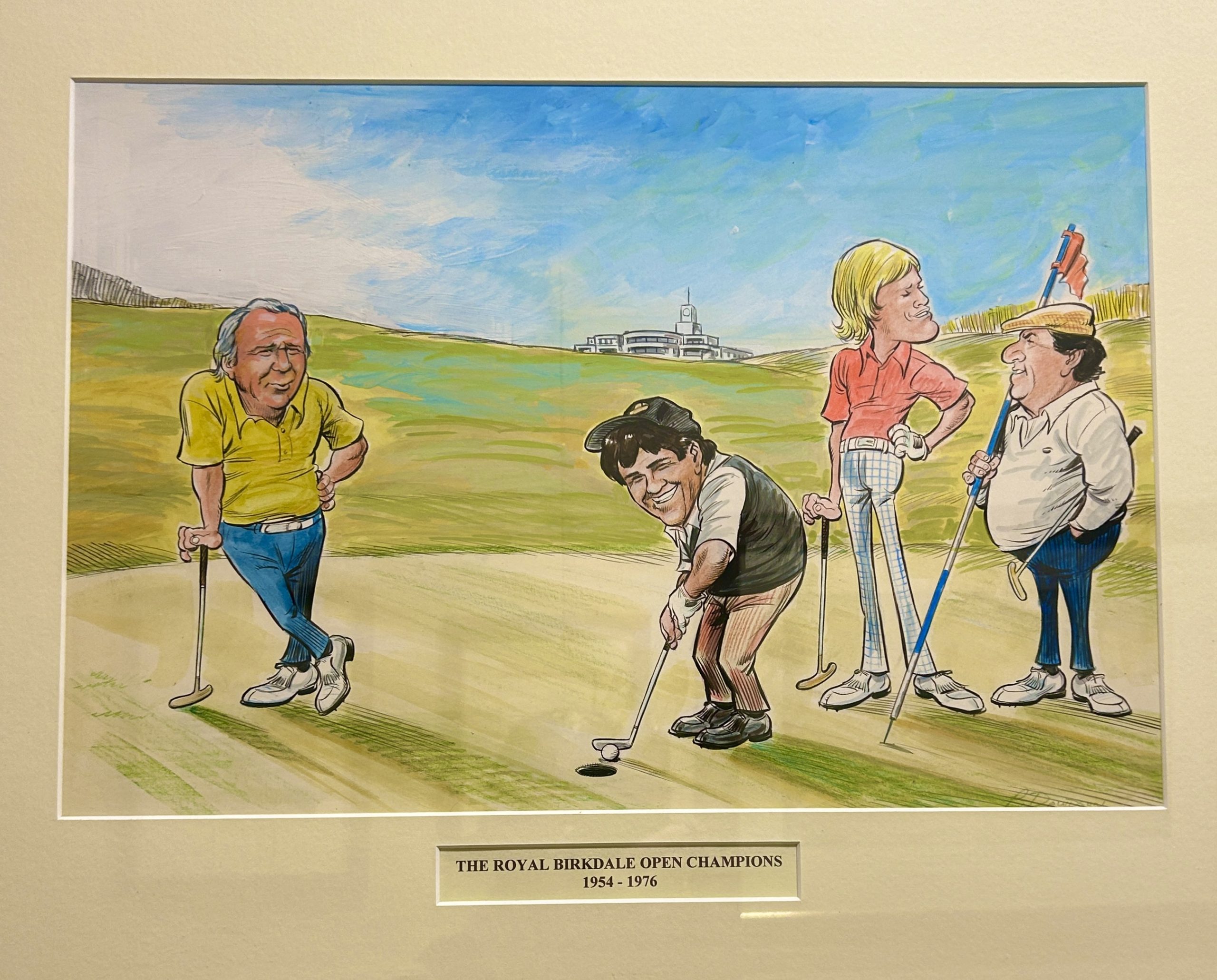
The late 1800’s must have been an interesting time for golfers in this area of England as four of the five courses we have played were founded within a decade of each other the sole exception being Royal Liverpool that was founded in 1869. In the case of Royal Birkdale that was 1889 with the current course opening in 1897. While the first four courses we have played all had connections with some of the most illustrious names in the game – Old Tom Morris, Willie Park, Harry Colt and James Braid, not so Royal Birkdale which was the product of George Lowe, the man who did the original design for Royal Lytham & St. Annes and was the pro there for many years. However, while Royal Lytham was extensively redone by Harry Colt, that did not happen at Royal Birkdale and itt remains the best known of the 40+ courses that Lowe designed. If it turns out that Royal Birkdale is in fact a better course than the other two royals then Lowe definitely deserves more credit for his design abilities and not just his club making for which he is properly considered a trail blazer.
While Royal Birkdale may not have had the celebrity architect cachet of other courses in the area it has more than made up for it in the list of players who have won The Open here as you can see from the caricatures above. The club obtained its Royal status in 1951 and hosted its first Open in 1954 which Peter Thomson won. He won again in 1965 for his fifth Open title. Arnold Palmer won in 1961 and is commemorated with this painting which shows him hitting a six iron out of a blackberry patch on the 15th hole after his caddie urged him to just punch it out. Instead he salvaged a par and won by a stroke.
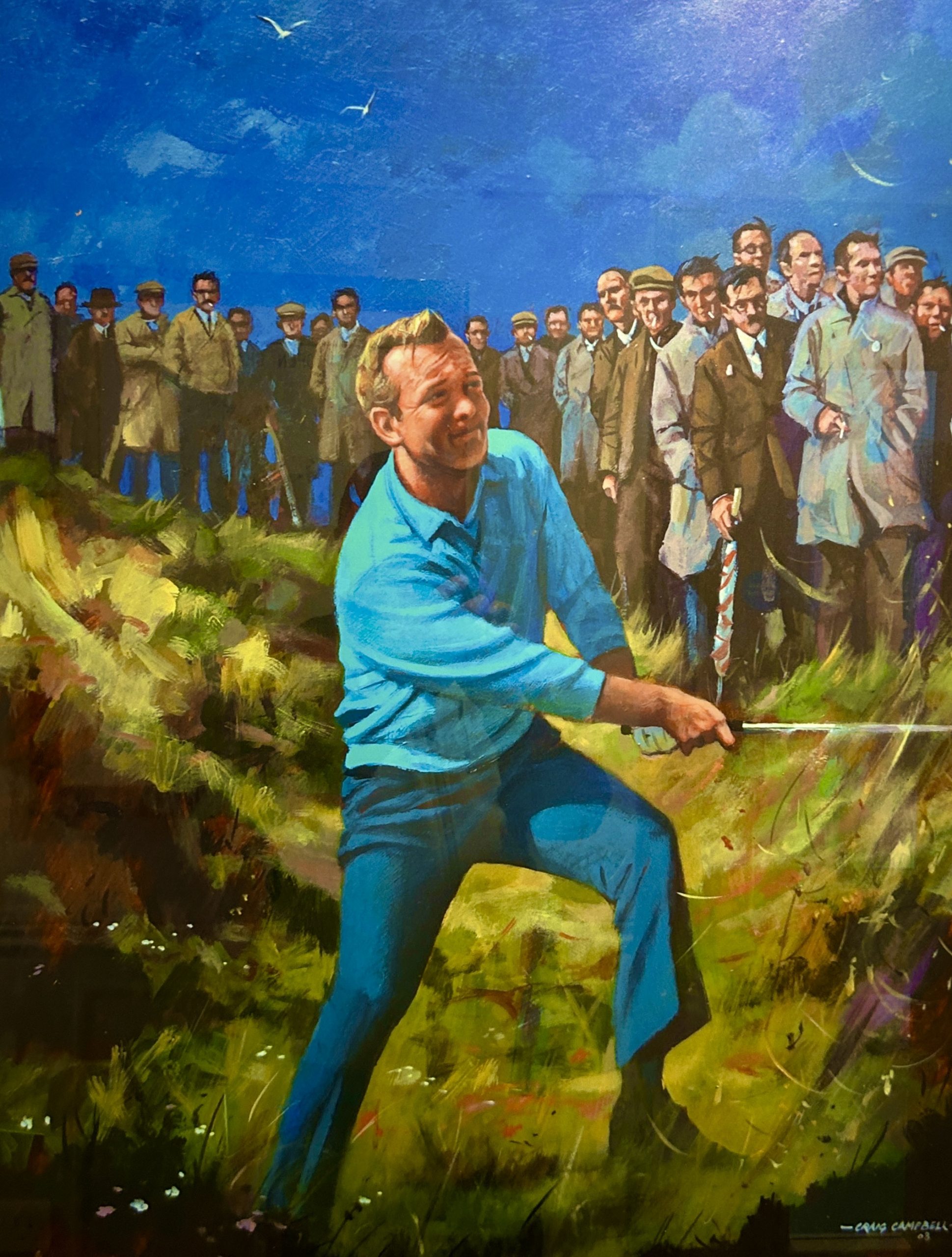
Other winners included Lee Trevino, Johnny Miller, Tom Watson, Mark O’Meara and Padraig Harrington all of whom are in the World Golf Hall of Fame. Another who will be is Jordan Spieth who won in 2017 with another miraculous shot on 13 which he describes in this short video.
The only man to win the Open here who is not Hall of Fame material was Ian Baker-Finch who but for his psychological problems which forced him to quit the game prematurely, might have made it as well.
Aside from The Open, Royal Birkdale has hosted The Amateur and the Women’s Open numerous times as well as the Walker and Curtis Cups. It was also the site of one of the more notorious moments in the Ryder Cup when in 1969 Jack Nicklaus conceded a two foot putt on 18 to Tony Jacklin leading to the first tie in Ryder Cup history and a huge boost for the UK/Ireland side that had been beaten like a drum by the Americans in the previous five. While Nicklaus was applauded for his sportsmanship others thought he never should have given ‘the concession putt’.
The first thing you notice upon entering the grounds at Royal Birkdale is the art deco clubhouse which contrasts mightily with the others on England’s Golf Coast. At first I thought it a bit of a white monstrosity, but it definitely grows on you and my final judgment is that it is a daring piece of clubhouse architecture.
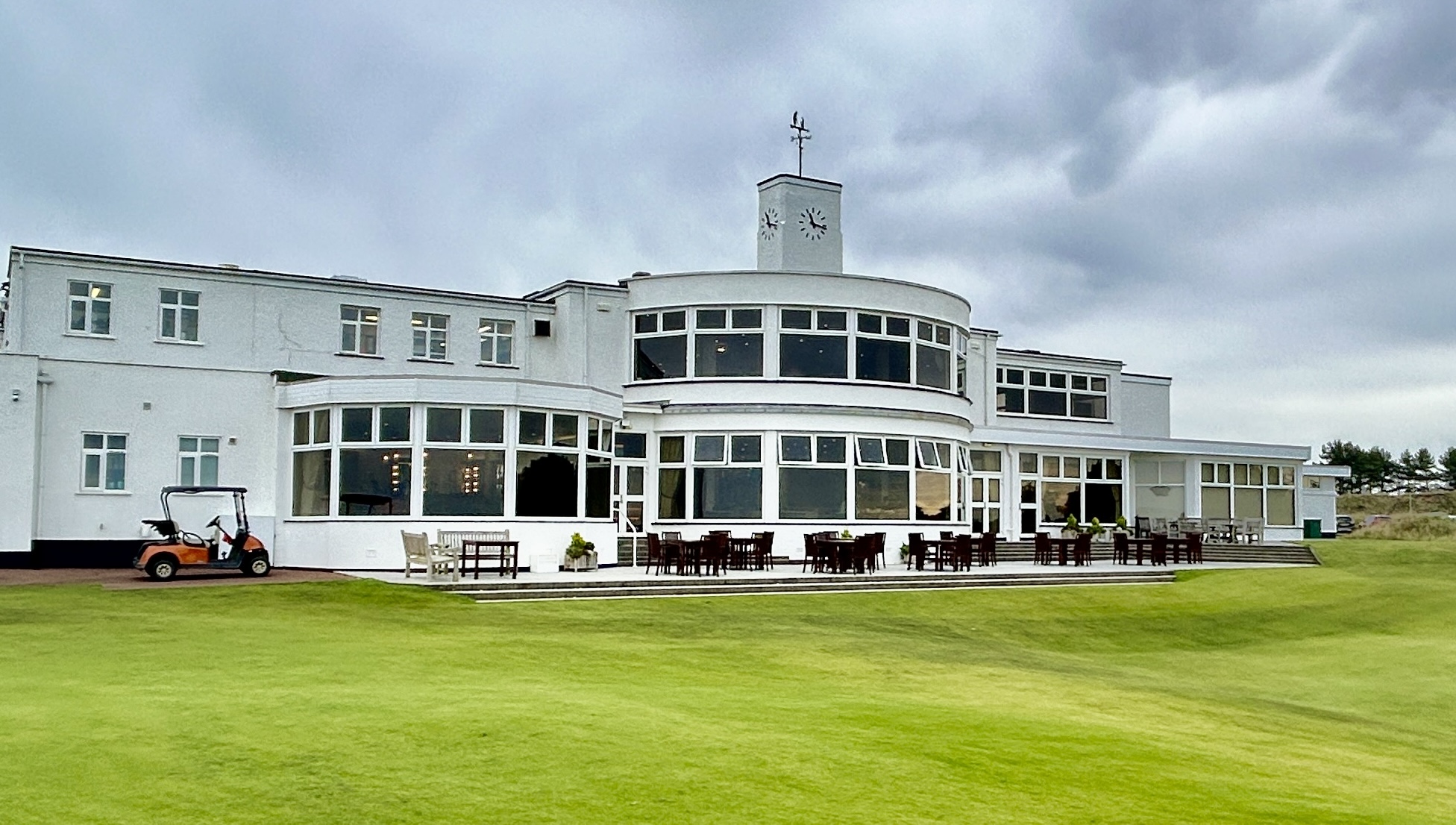
Royal Birkdale has a proper driving range which you are transported to by cart so you don’t have the excuse used at Royal Lytham that you didn’t get a chance to warm up.
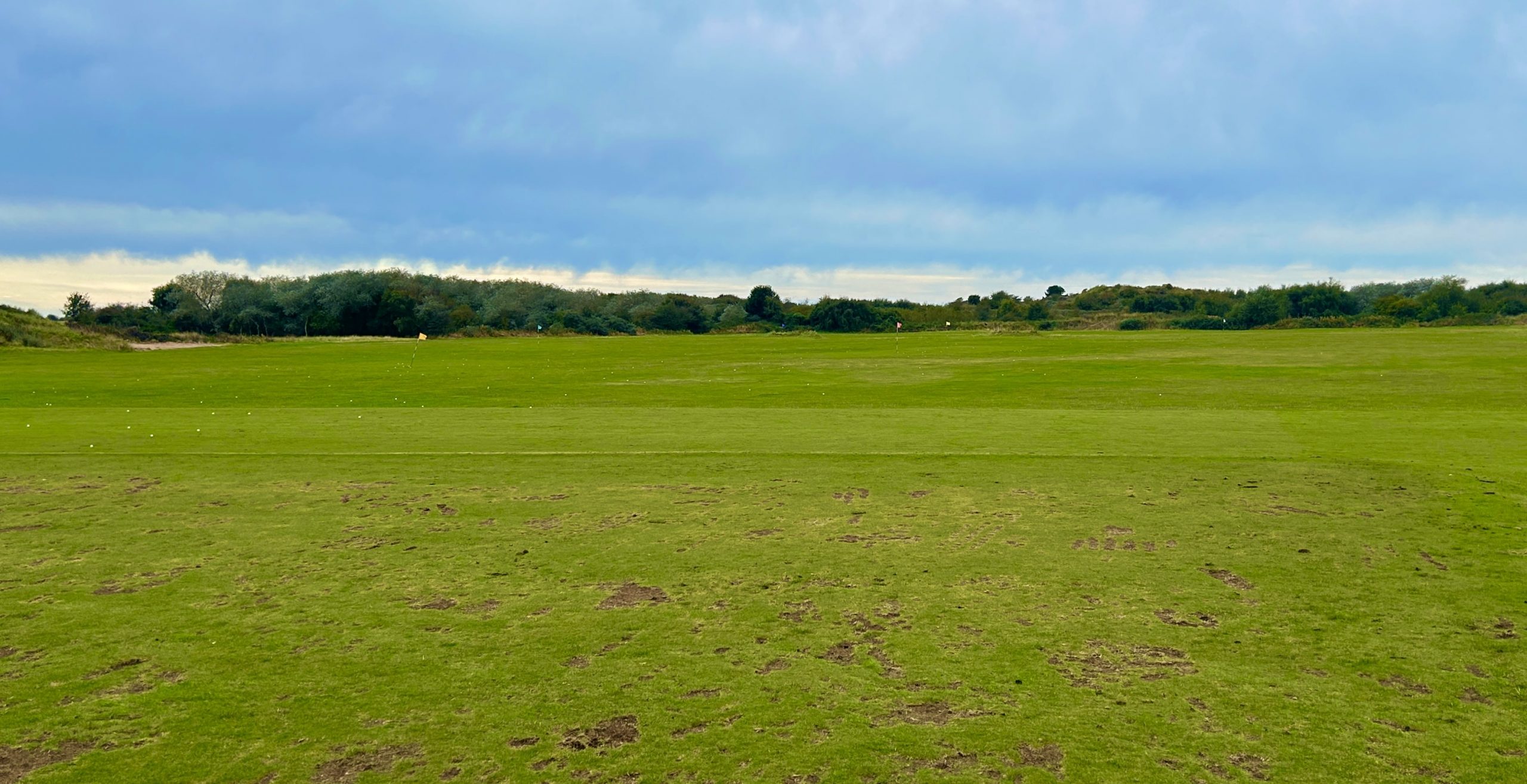
After hitting some balls and putts we meet our caddies at the Starter’s Hut.
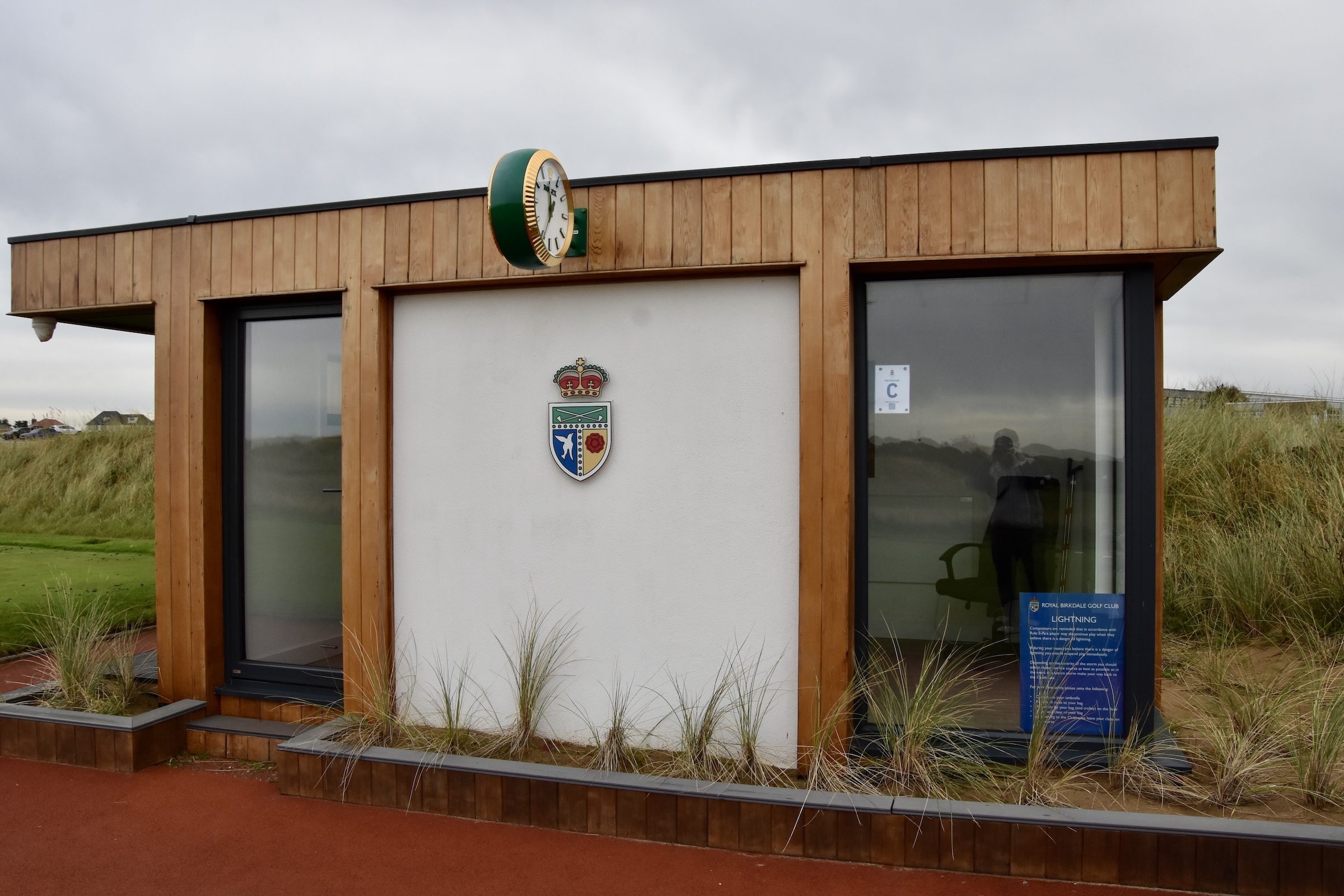
As with the other rounds we have our clubs on pull carts and the caddies are their for guidance, distance, finding errant balls and reading the greens, plus great story telling. I took this picture after the round and you can see that everybody is all smiles so it must have been a great day.

Let’s find out.
While Royal Birkdale can play over 7,200 yards for The Open, we are playing a much more modest 6,297 from the yellow tees. Interestingly, instead of having one scorecard that shows the distances from each tee box, at Royal Birkdale you get a scorecard that is specific to the tees you are playing.
Royal Birkdale #1 – 430 Yard Par Four
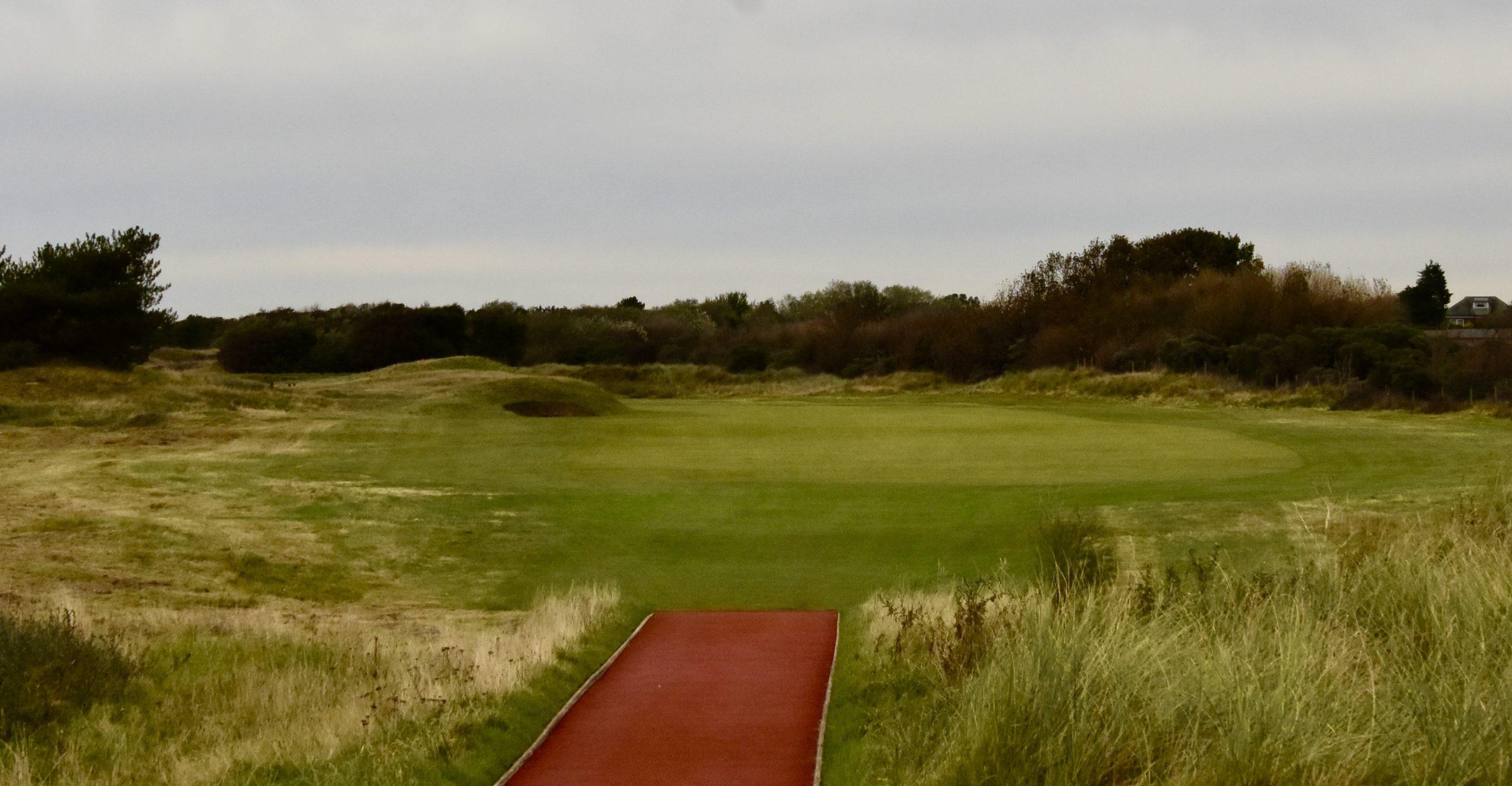
Royal Birkdale starts out with a very long dogleg left that despite its length is only the #11 stroke hole. There is OB all down the right side, but the fairway is generous enough that it shouldn’t be a concern. What is, is making it to the end of the dogleg so you can see the green on the second shot. That’s not a worry for guys like Rory and Dustin who just bomb it over the trap and only have a wedge in.
I did hit a decent drive and rounded the corner expecting to see the green and instead saw that the hole was really a double dogleg.
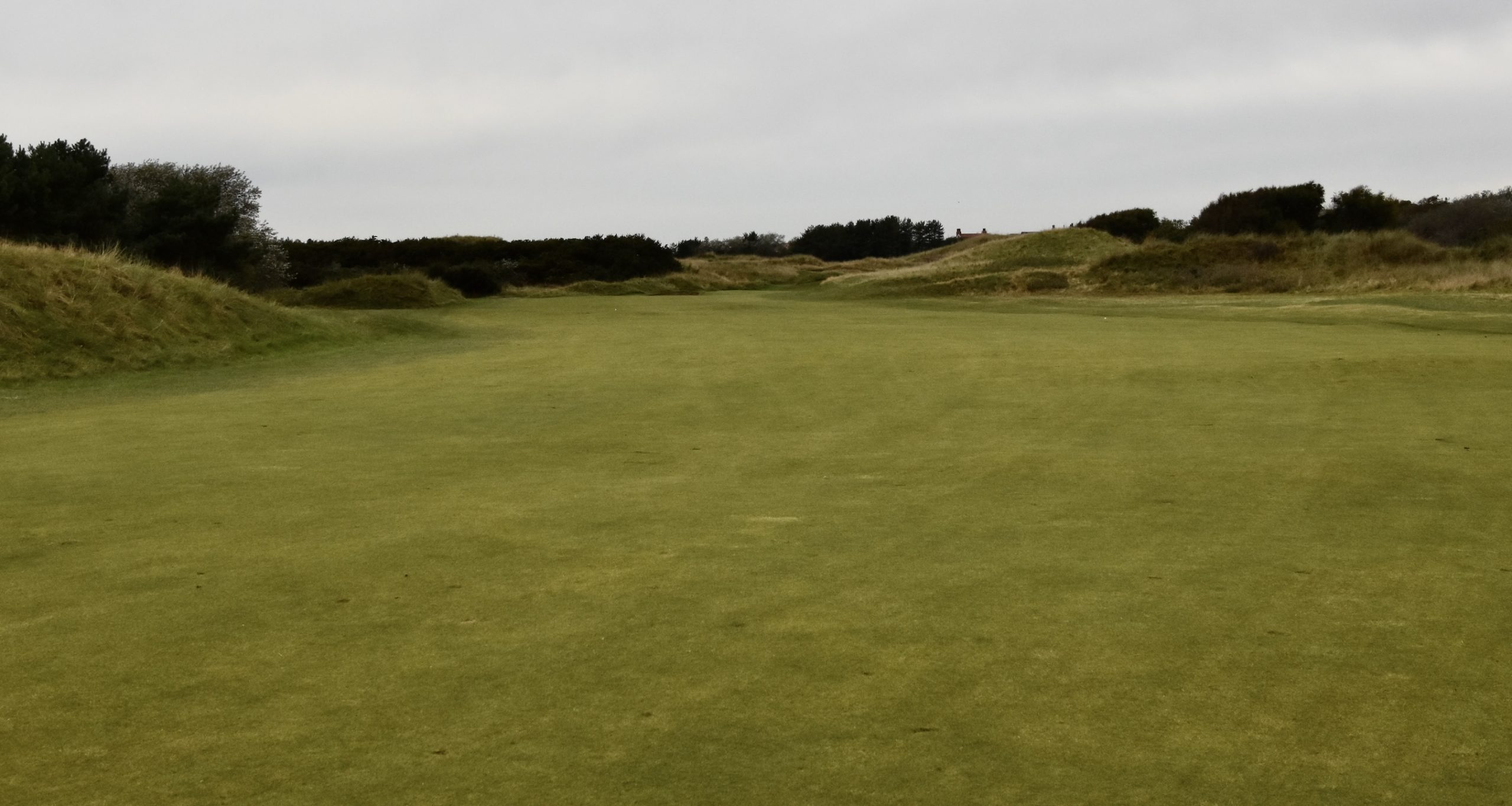
There was no way in hell I was reaching this green in two, so it was a hybrid up to here for the approach shot to a flat green surrounded by fescue and bunkers, but with enough room in front to do a bump and run.
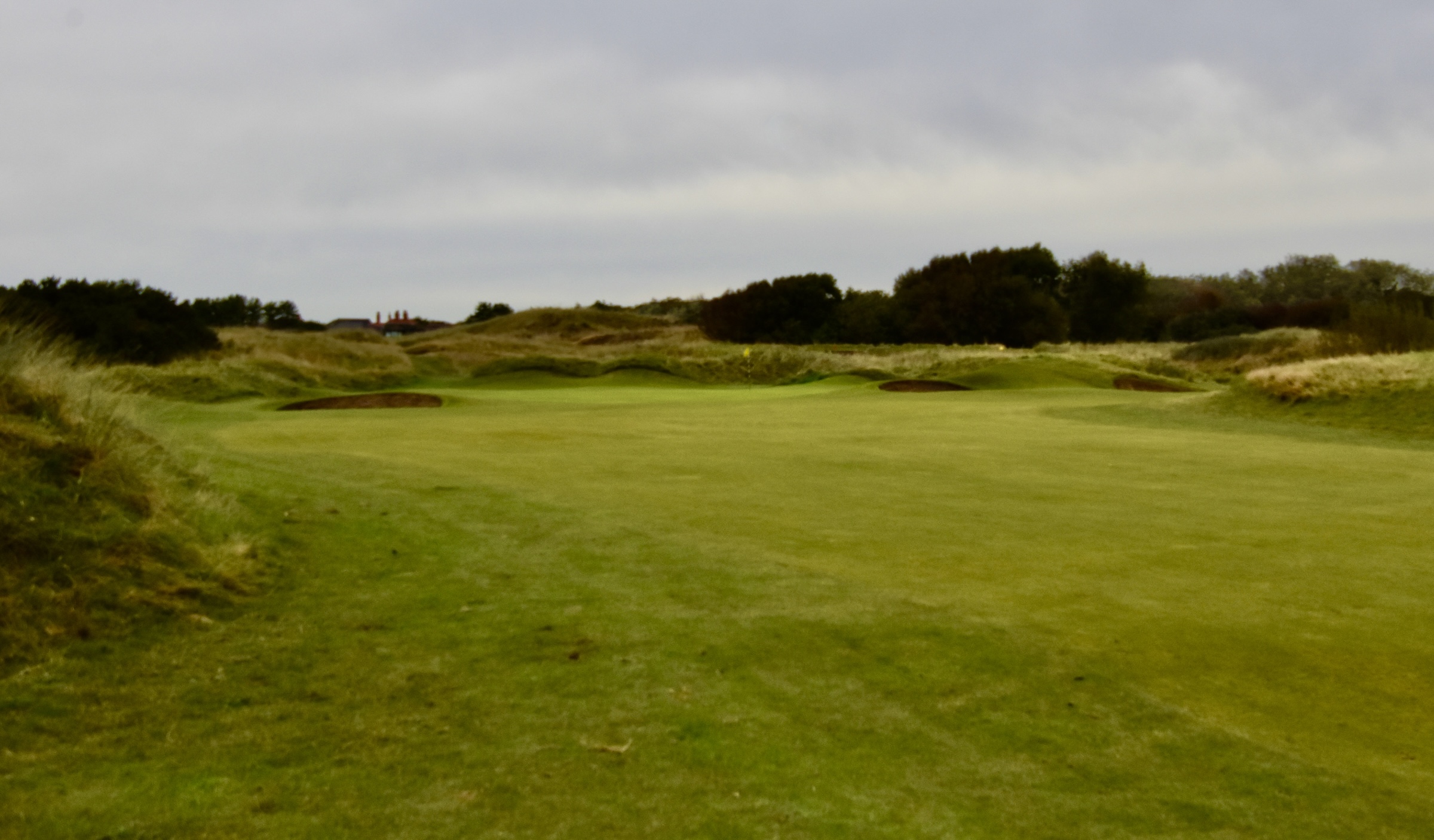
One of the caddies pointed out that Royal Birkdale is designed so that in almost all cases you only ever see just the hole you are playing.
In terms of conditioning the greens were amazing and the fairways well manicured – what you should come to expect from an Open course.
BTW five is a very decent score on this tough starting hole which is longer than a number of the par fives we have played on the preceding courses.
#2 – 397 Yard Par Four
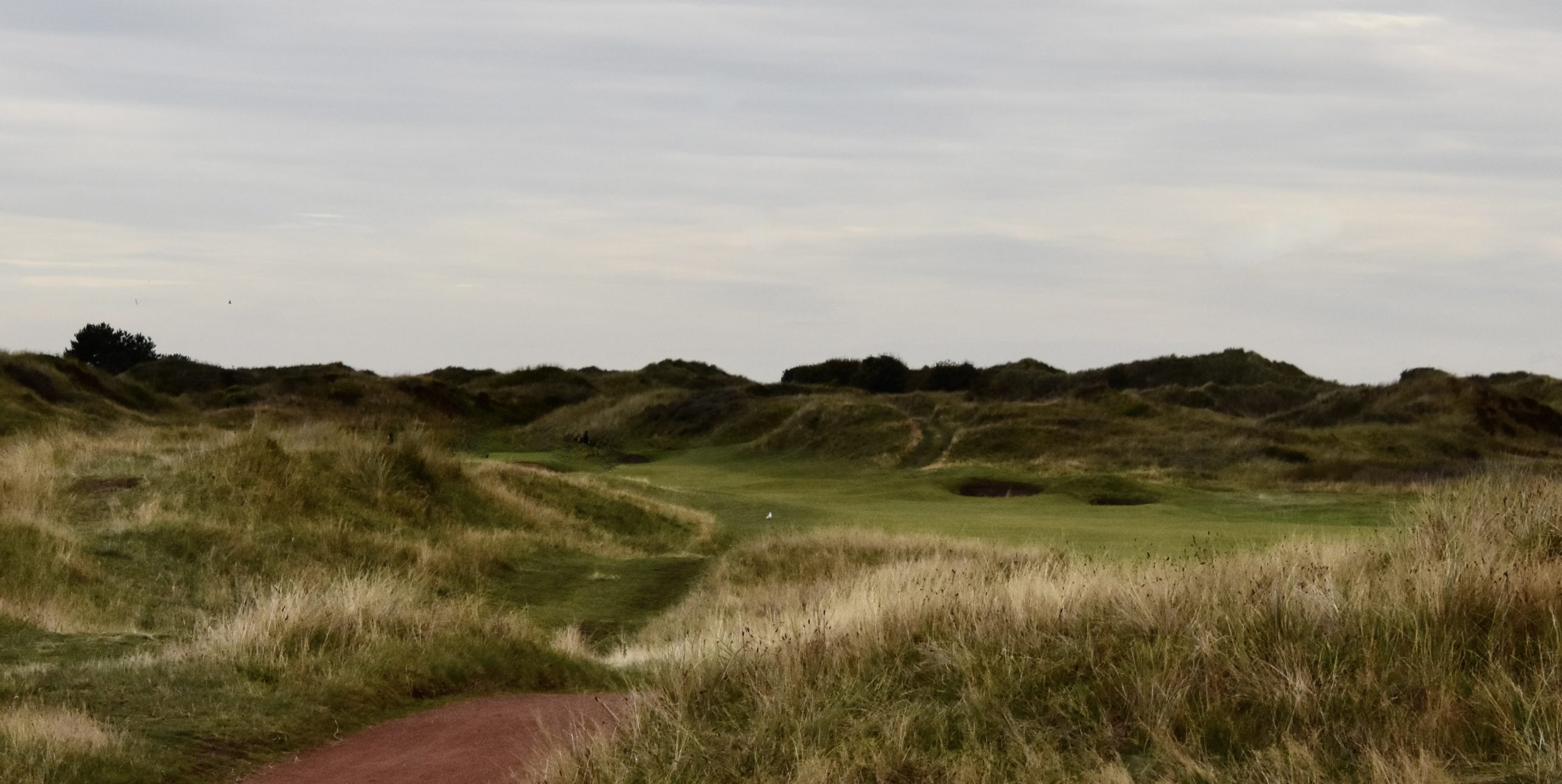
If you thought #1 was difficult then you are in for some real hair pulling on this hole. It is a true dogleg left and there is the possibility of cutting off some of it, but if you fail the rough is beastly. If you forego that approach you must avoid the two bunkers straight away.
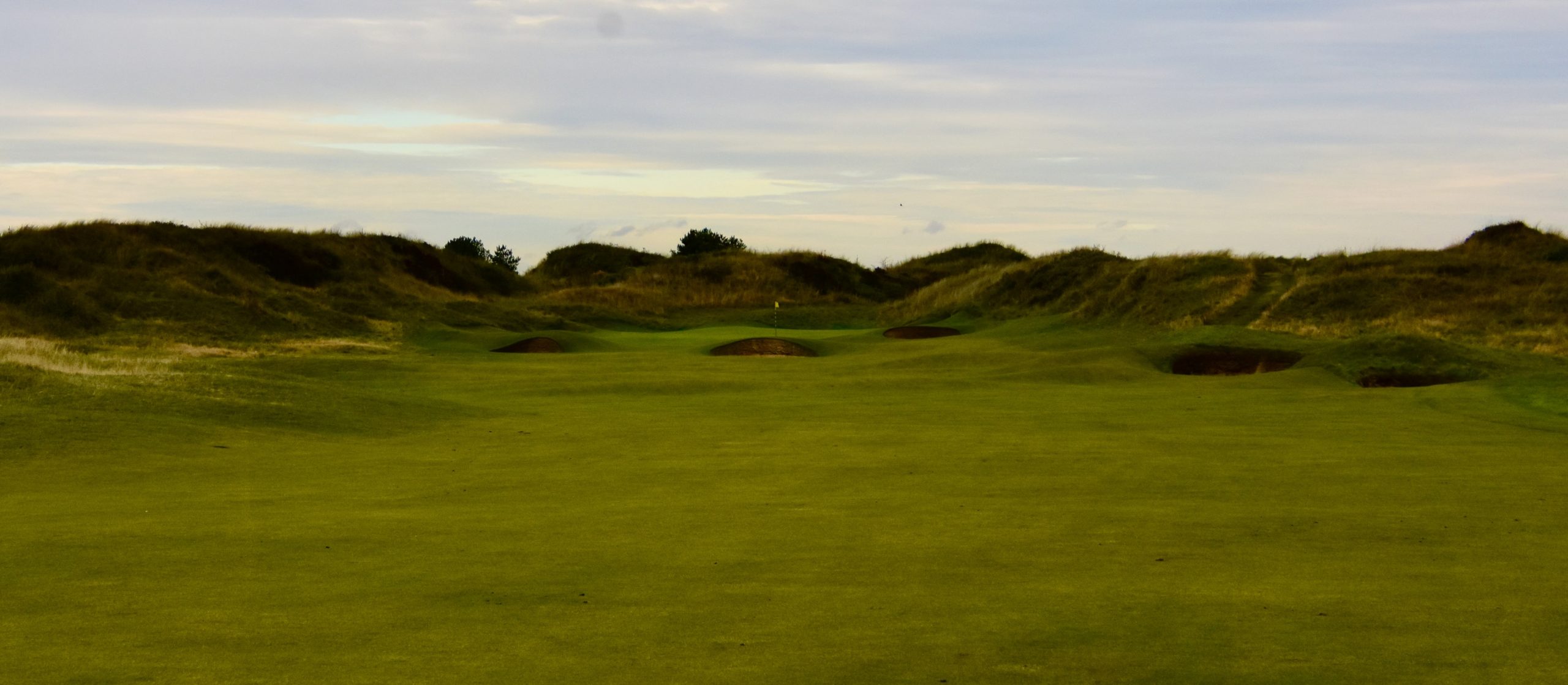
Ok, the fairway bunkers are way further off the tee than I thought and I’m safely in the middle of the fairway. Unlike #1, I can see the small green that is guarded by a plethora of bunkers. Anything that veers left or right will end up in the rough so on the advice of my caddie I don’t try to reach the green, but layup just short of the left front bunker from where I can putt. Another bogey, but things could be a lot worse on the #3 stroke hole.
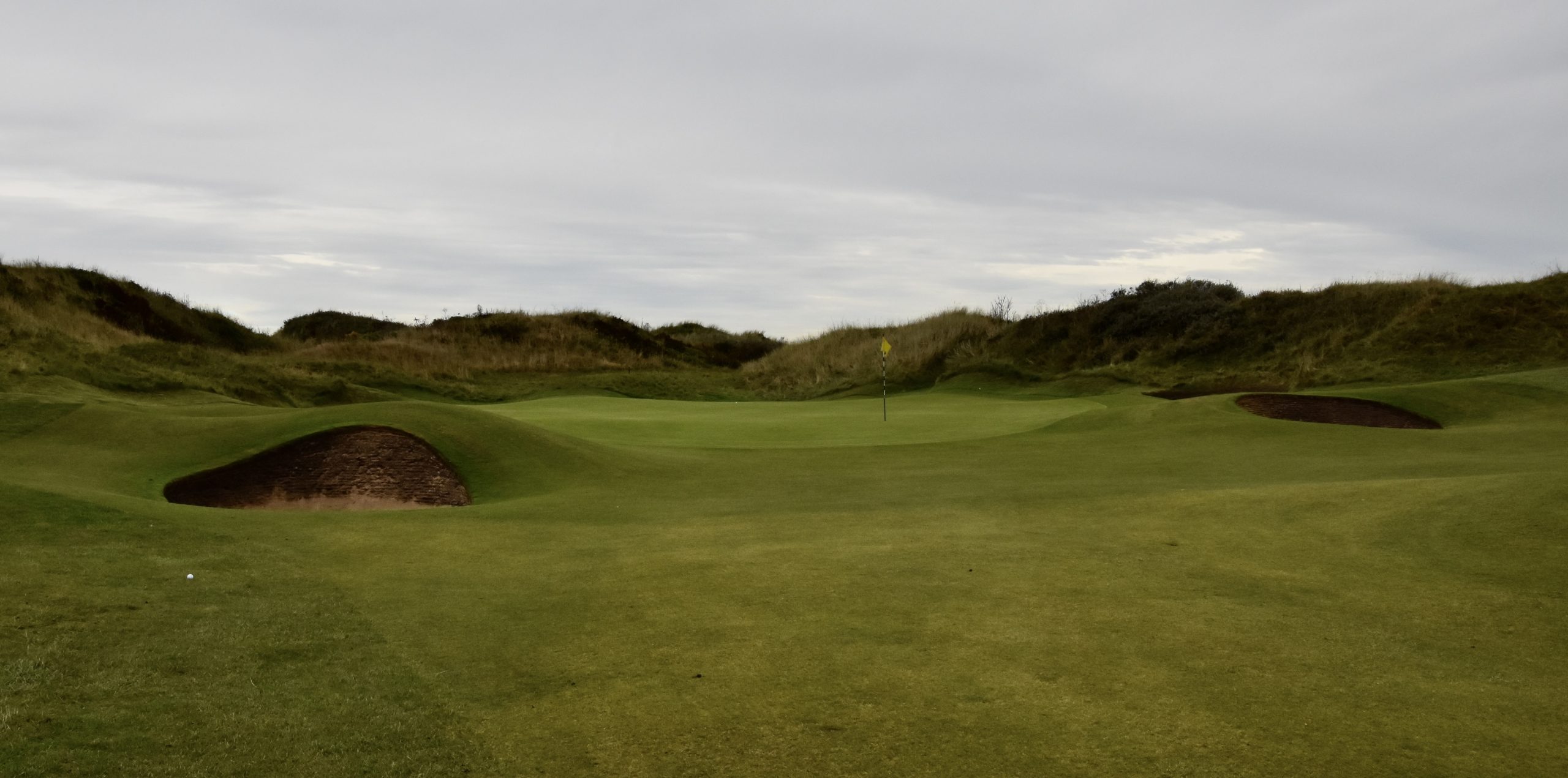
Royal Birkdale #3 – 372 Yard Par Four
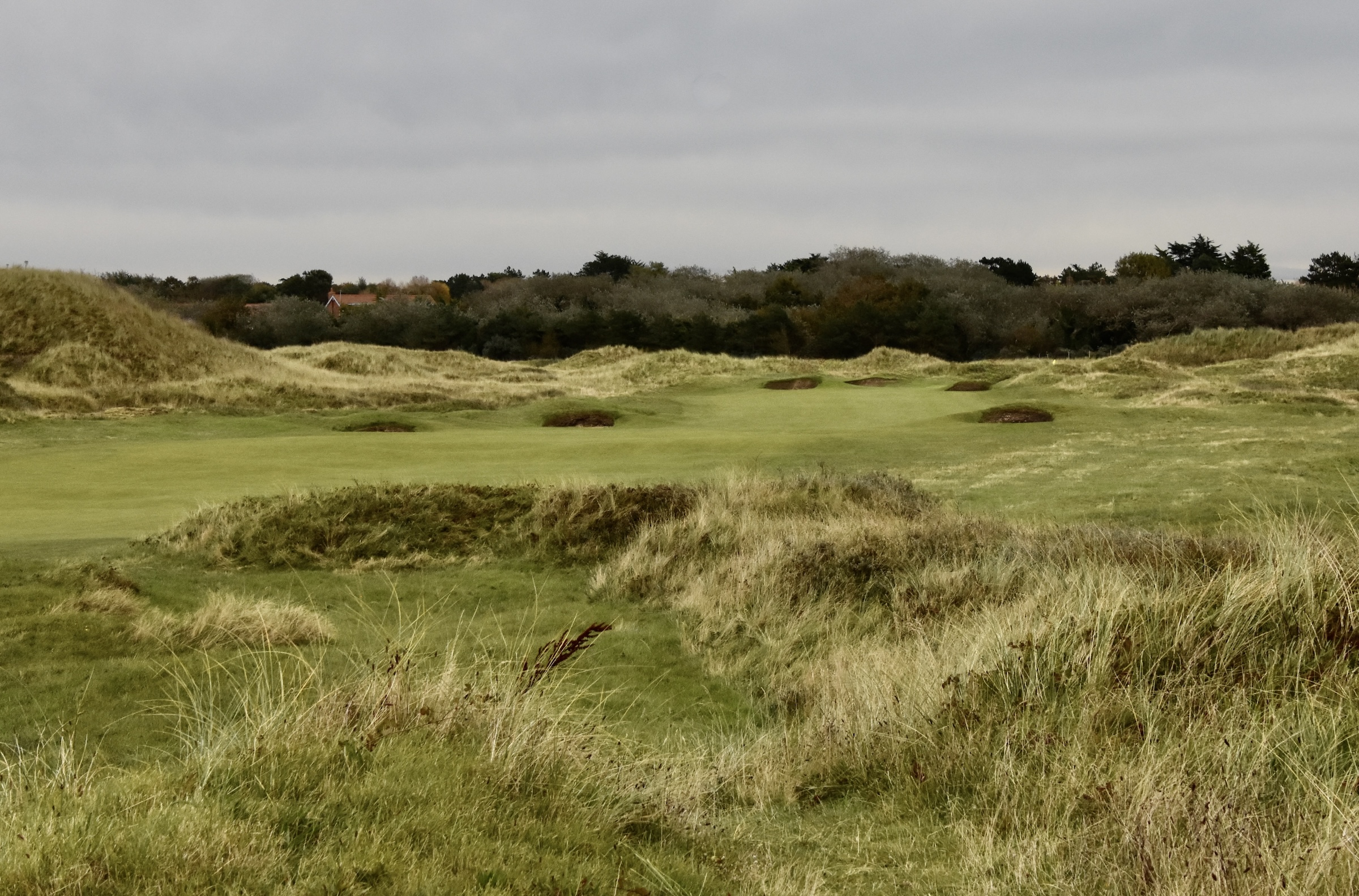
This is the third difficult par four in a row starting off Royal Birkdale. This is the most difficult drive of the three with bunkers on both sides of the fairway. You also need to be left to get a decent view of the green – you can just see the top of the flag over the bunker to the right.
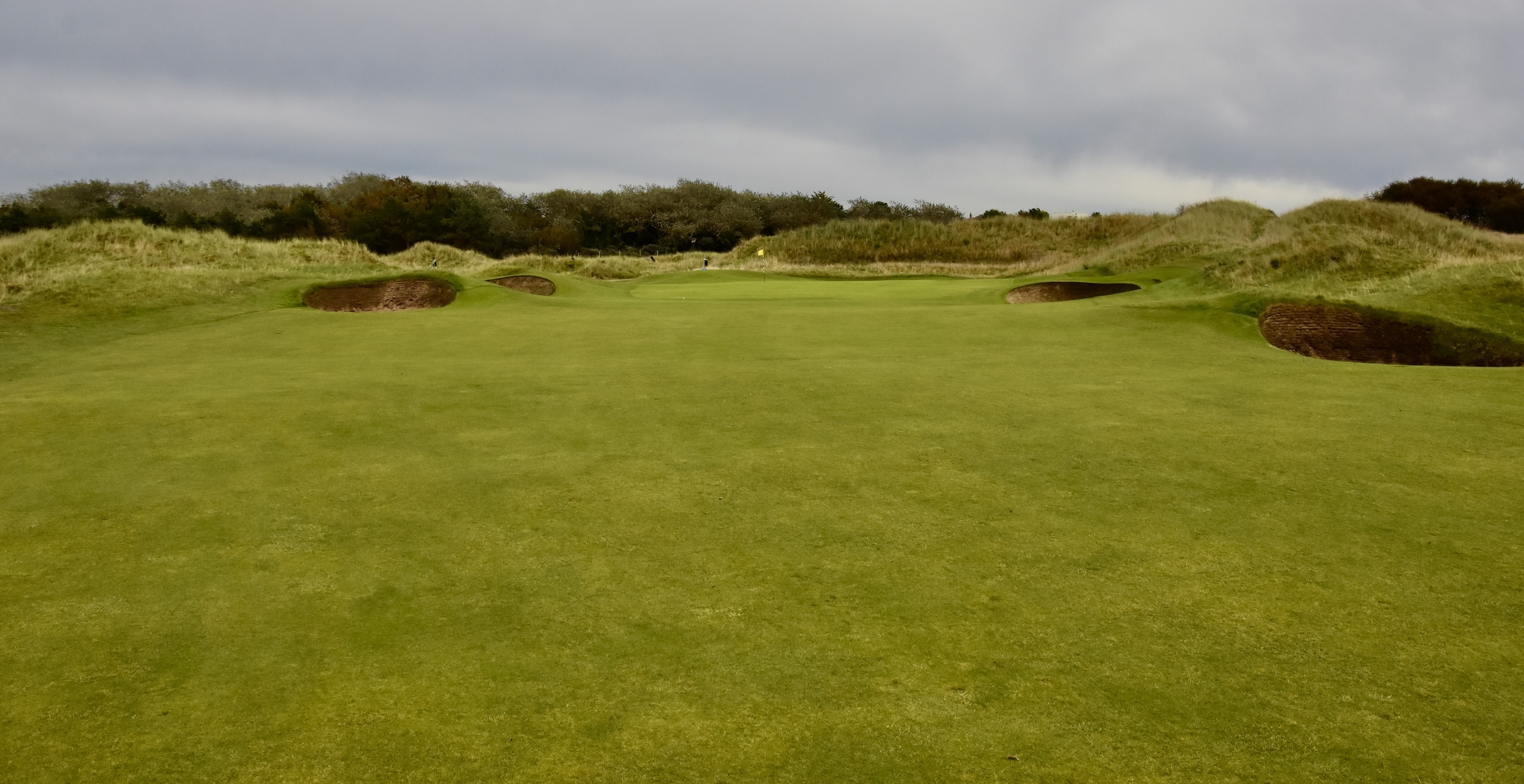
Once again I’ve gotten lucky and am in a good position off the tee with this view for the approach shot. It looks quite doable, but there is a stiff right to left wind that needs to be taken into account. By now I am seeing a pattern at Royal Birkdale whereby each green is tucked between high grassy mounds on all sides but the front. Short is much better than long here and the shot will get a lot of roll on this fairway. If it’s straight you might have a birdie putt, if it’s not, get out your sand wedge.
#4 – 177 Yard Par Three
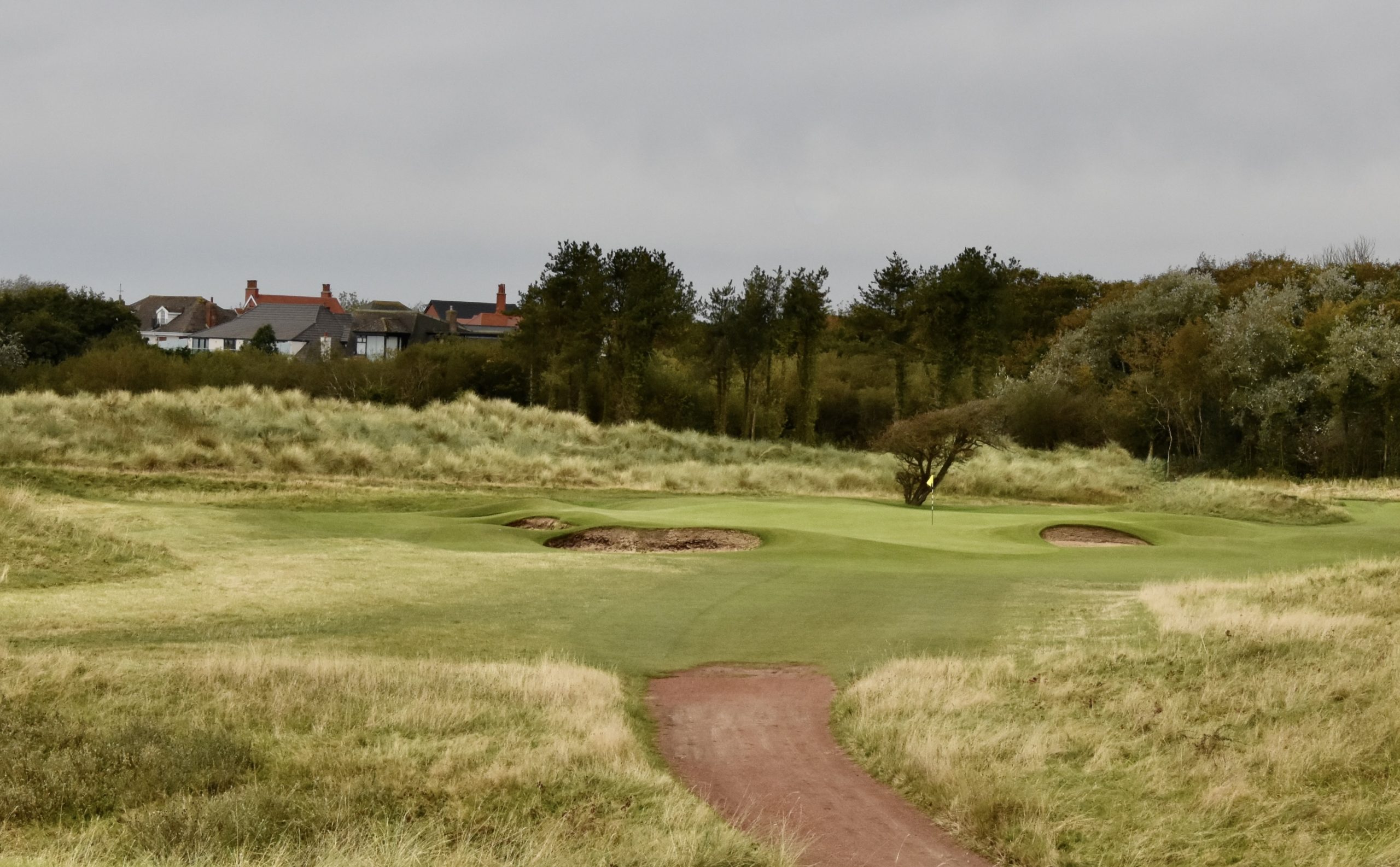
The first par three at Royal Birkdale is fairly straightforward with club selection being the most important thing on this hole that plays slightly downhill. The bunker on the right is perfectly placed to collect any ball that falls short as the fairway acts like a funnel leading into it. There is also a lot of contour to this green bringing three putts into play so although it’s the #15 stroke hole it’s no pushover.
Royal Birkdale #5 – 308 Yard Par Four
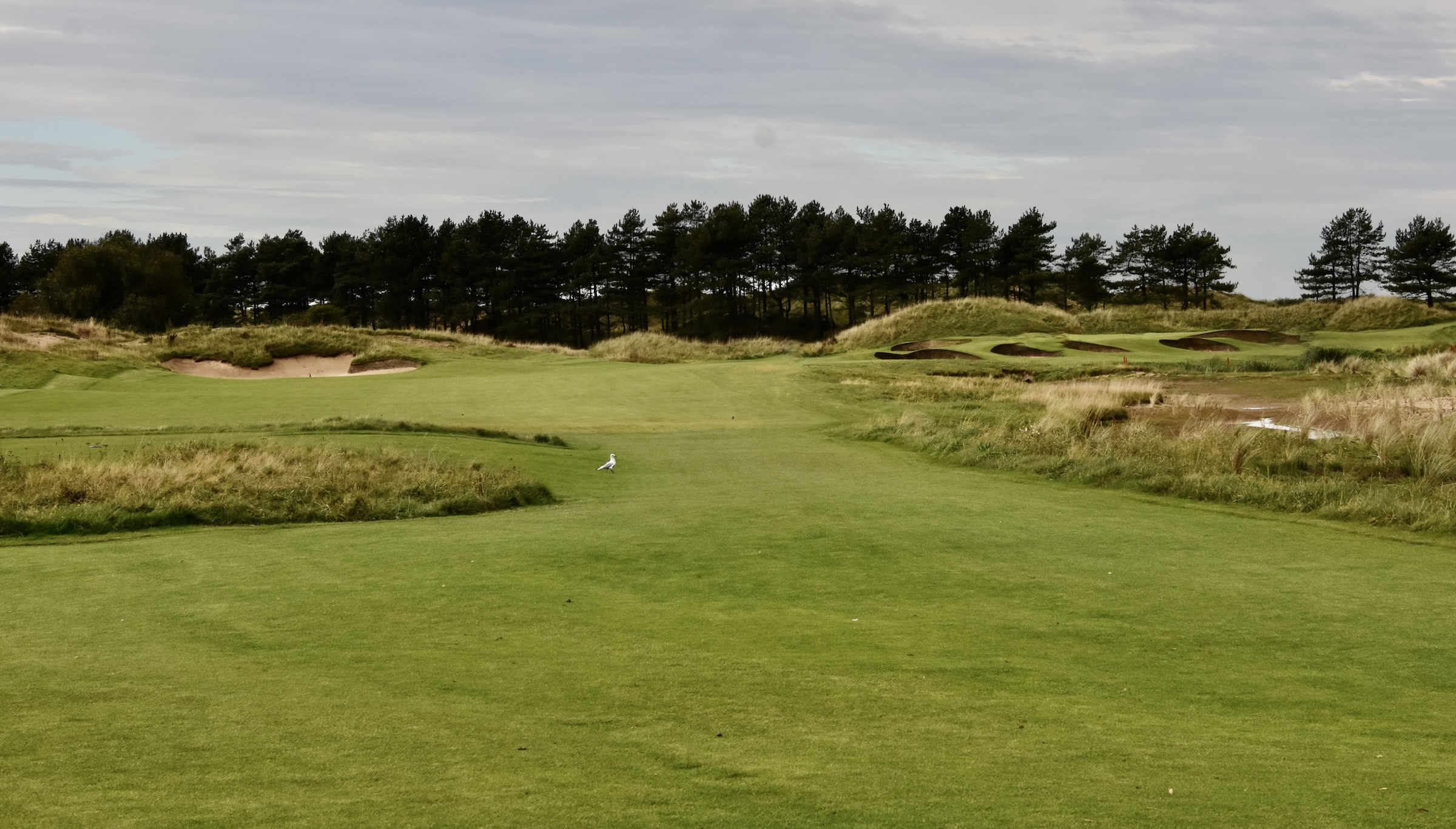
Finally, a short par four, but with a water hazard all down the right side that must have some kind of ball magnet in it because all four of us ended up in it; some more than once. During The Open this hole is a 346 yard par four that dares long hitters to go for it.
The proper play is to aim at the left side bunker which can’t be reached and then you’ll have a chance to come in at a good angle. You can see my ball, now retrieved from the hazard, still needs to traverse at least two bunkers before hitting the green which as usual has a series of fescued mounds behind it which is where you’ll end up if you take too much club.
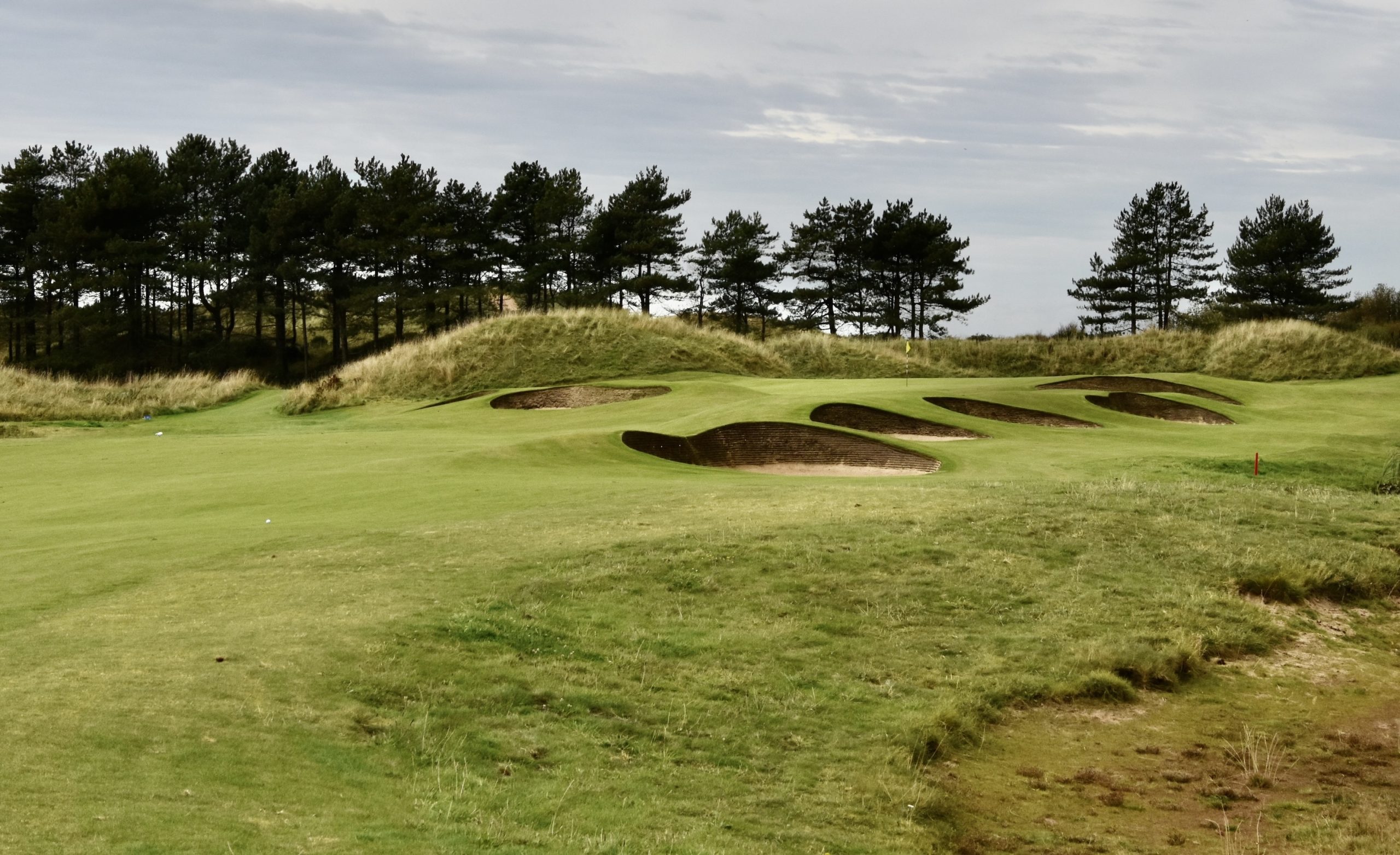
Now than I’m up here and see how well guarded the green is I can’t imagine how anyone could think of trying to drive it, but some do. This is a fantastic short par four, one the best on the trip.
#6 – 455 Yard Par Five
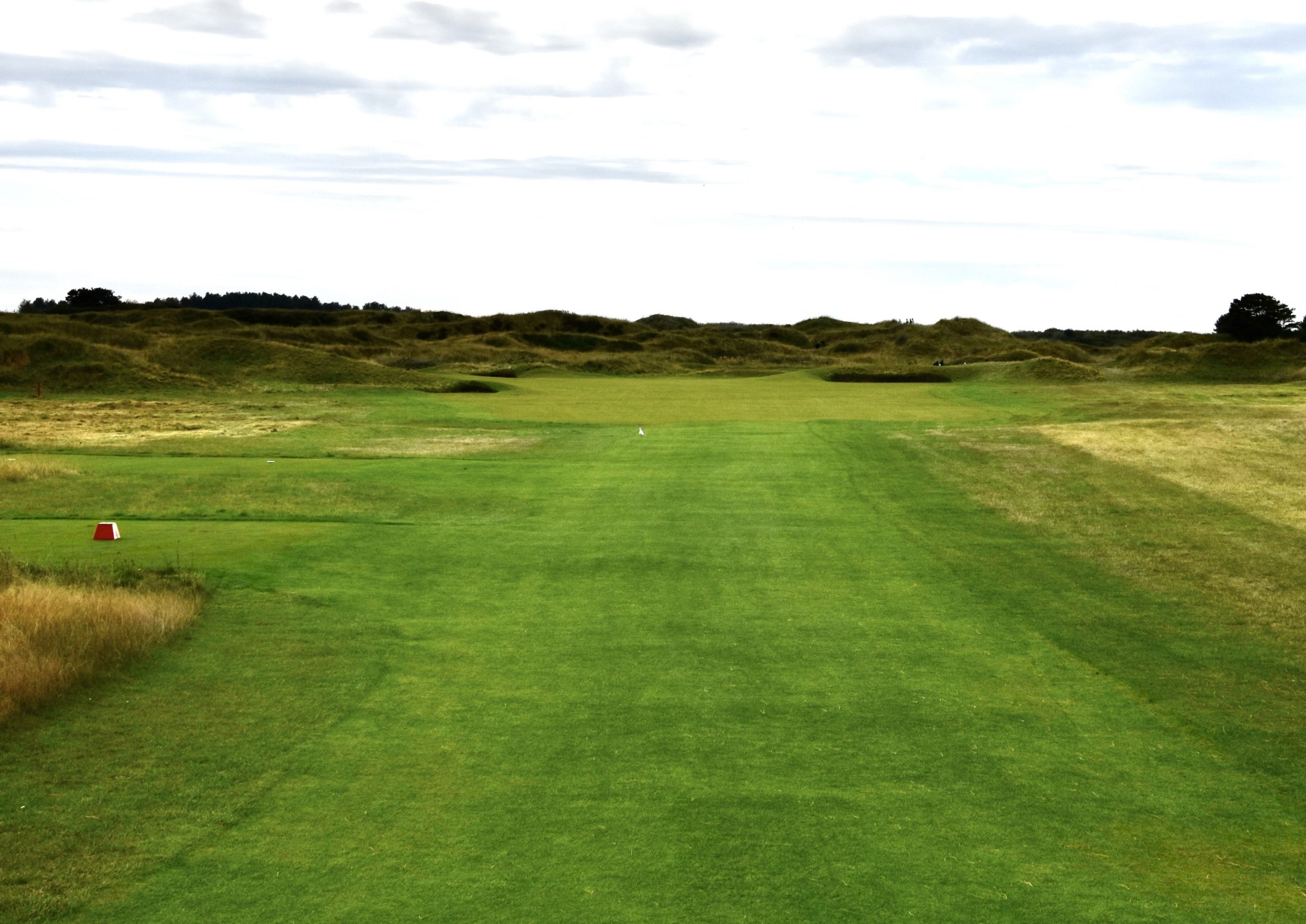
The only par five on the front is rated the most difficult at Royal Birkdale and incredibly plays as a 499 yard par four during The Open. It’s a three shot hole for our group with the focus on staying in the fairway for two consecutive shots to leave this approach to a tiny elevated green. It’s definitely a hole to play within your limits and not for any heroics. Do that and you just might par this beauty.
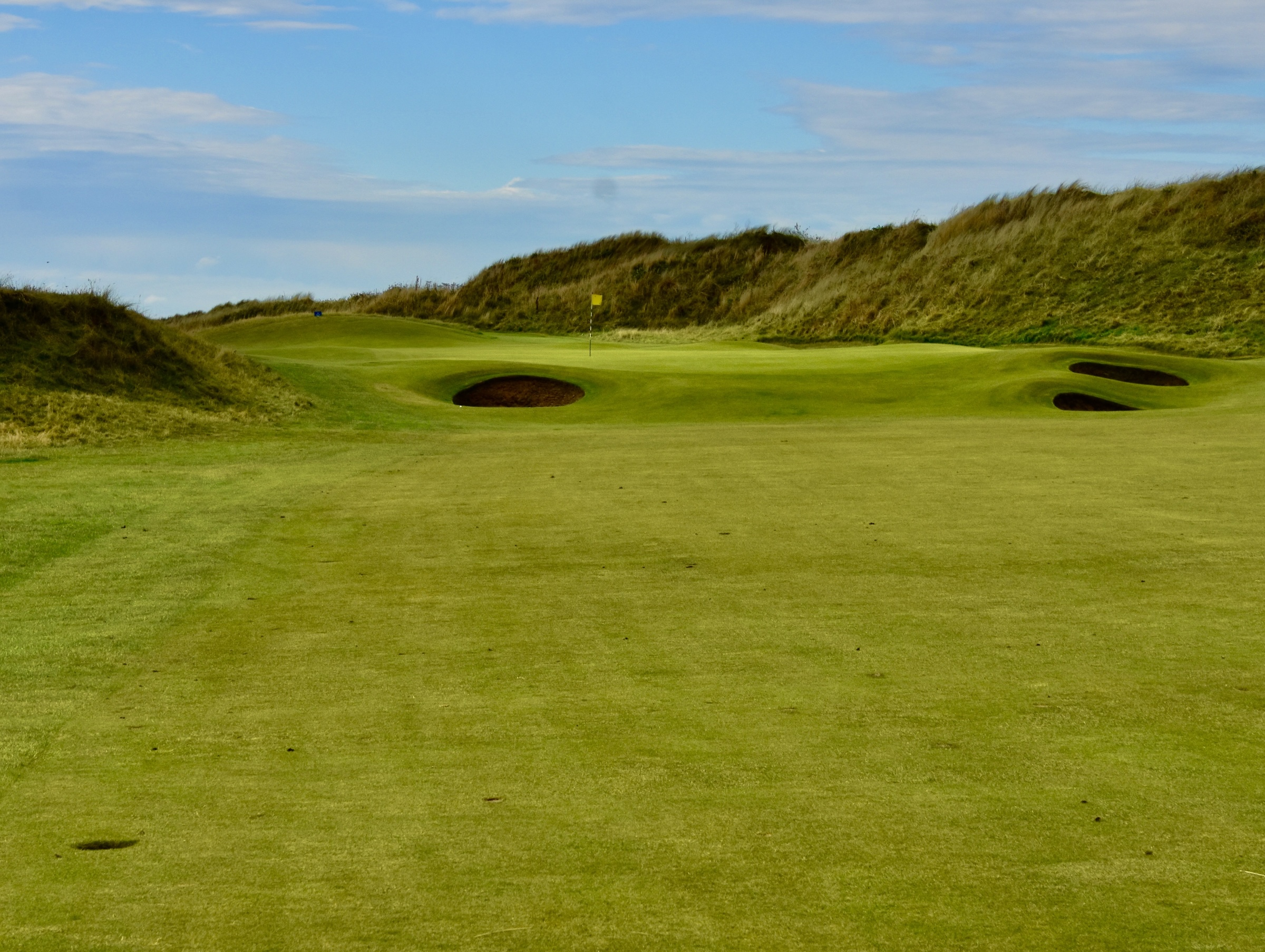
Royal Birkdale #7 – 125 Yard Par Three
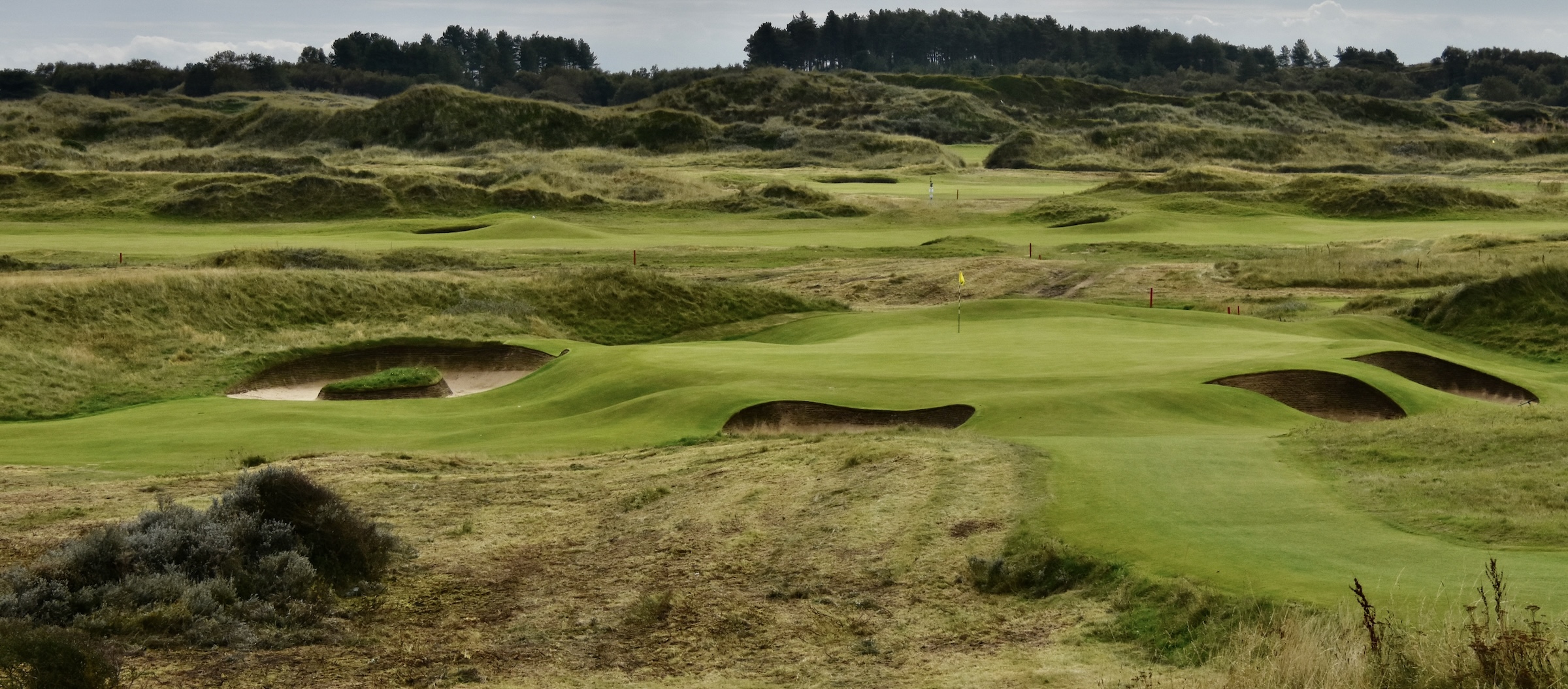
You go from the toughest hole at Royal Birkdale to the second easiest at #7. At only 125 yards and downhill it should be easy to hit, but it’s actually quite crowned and rolls off in every direction. This is the first hole that does not have mounds at the back, but quite the opposite, a steep gully behind. The bunker on the left with the island in the middle is probably what you will remember most about this hole.
#8 – 394 Yard Par Four
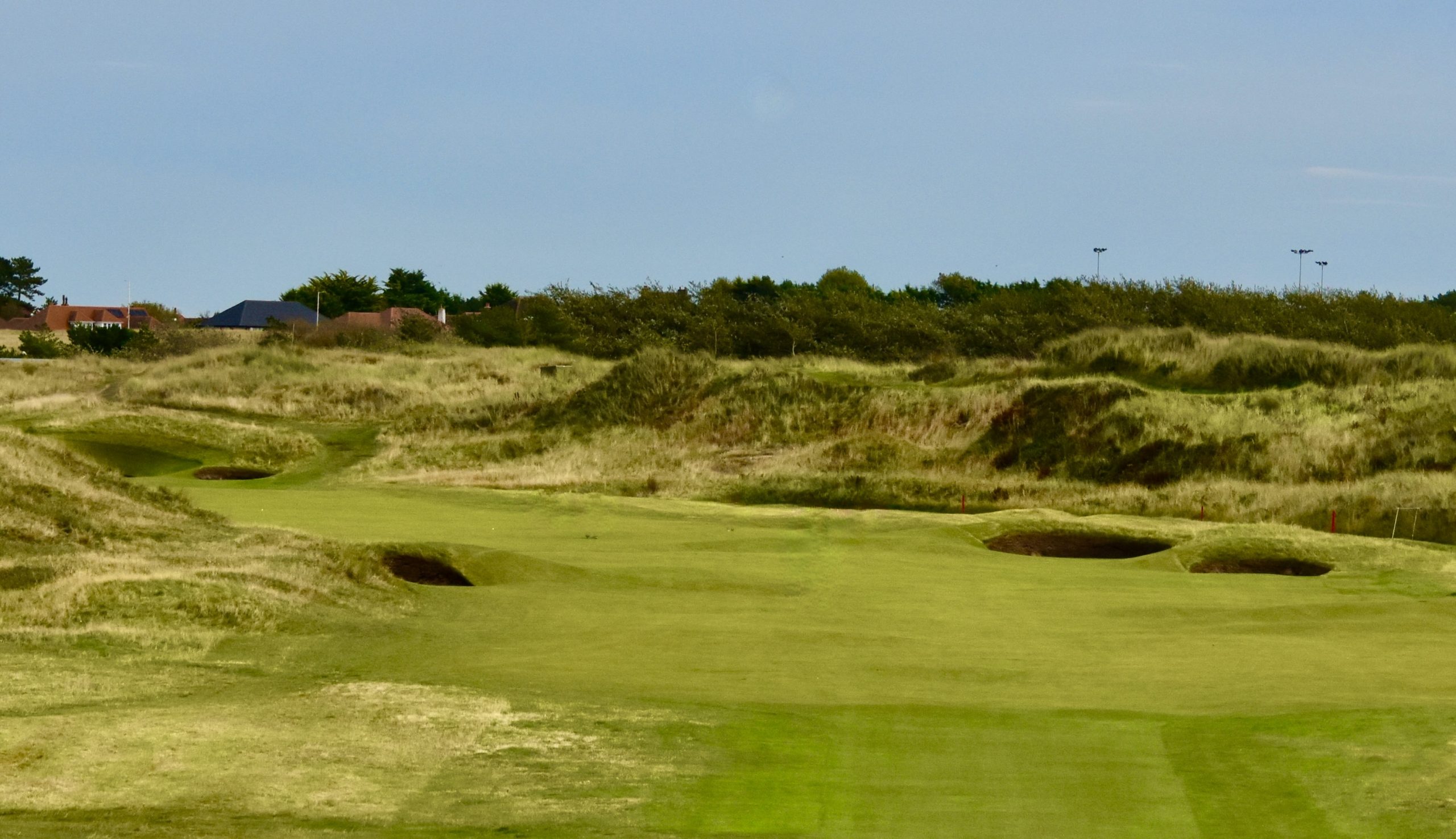
This is the view from The Open tees when the hole plays 458 yards long.
Fortunately we are playing from these tees where this is the view. Yes, it’s another dogleg left that has well positioned bunkers and mounds that require not only a straight drive, but decent length to clear the dogleg.
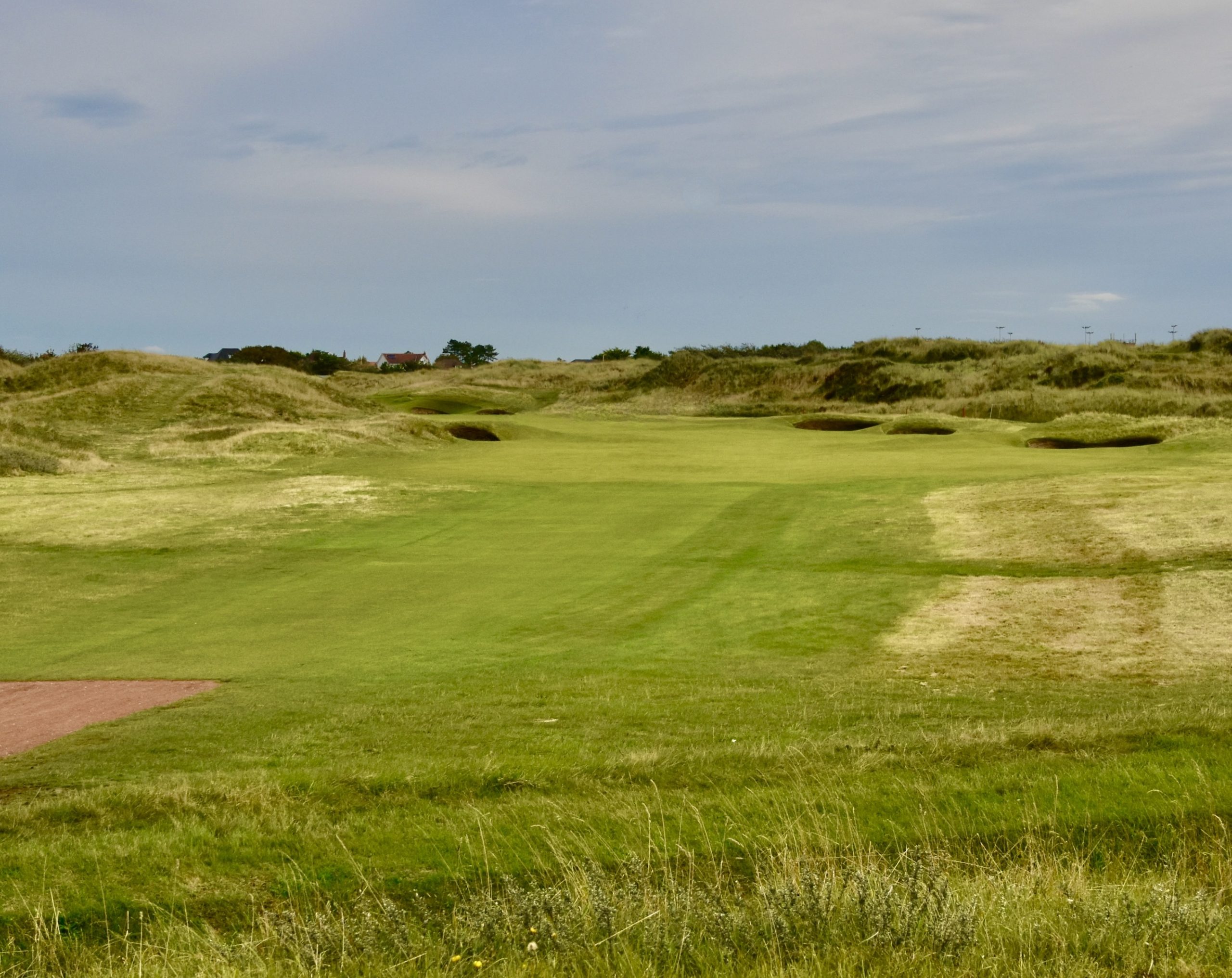
Assuming you do get that right then it still requires a good poke to get onto this slightly elevated green. As you can see two of my comrades have come up short.
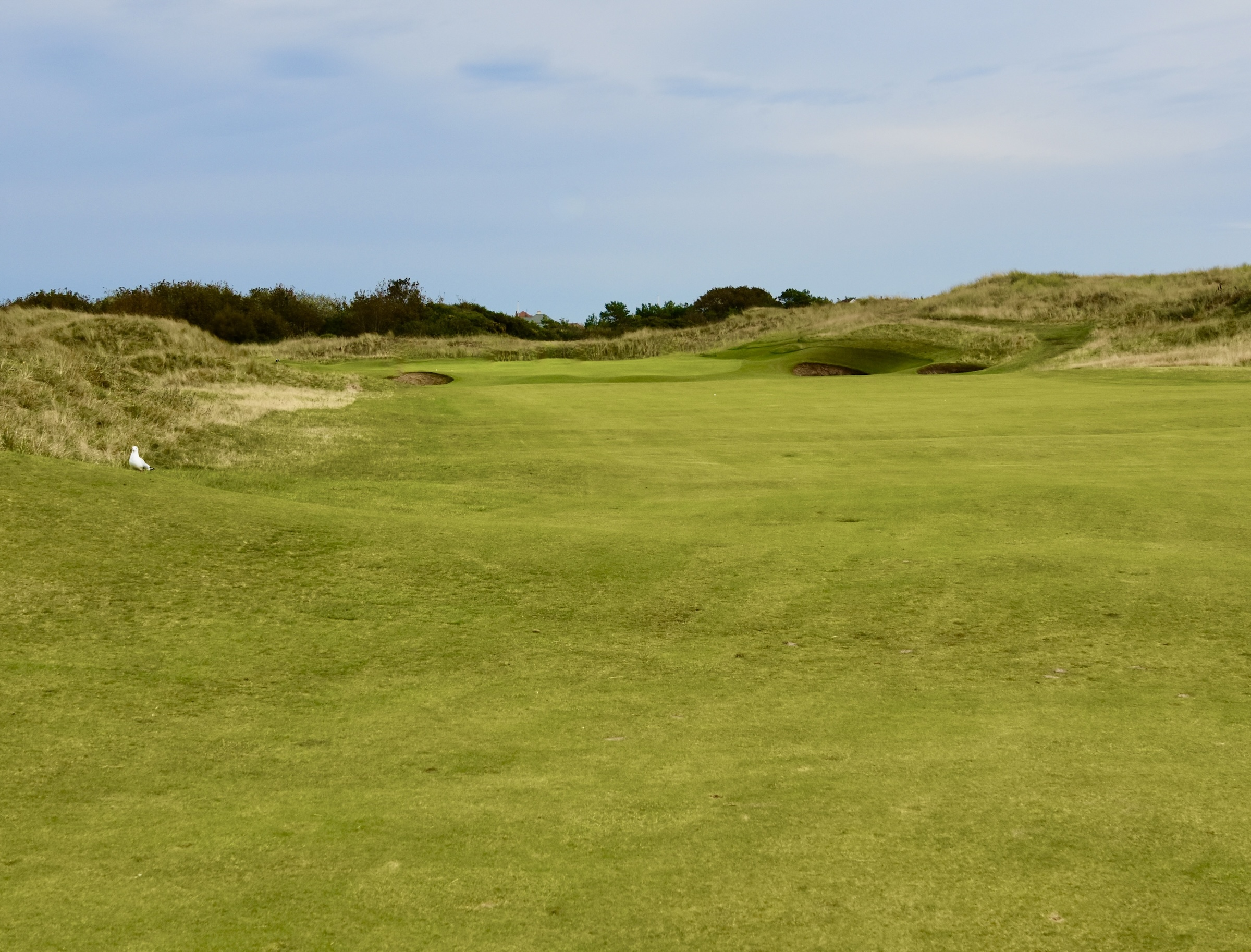
No 8 marks the fourth difficult par four on the front at Royal Birkdale and as we are about to find out, it’s not the last.
Royal Birkdale #9 – 399 Yard Par Four
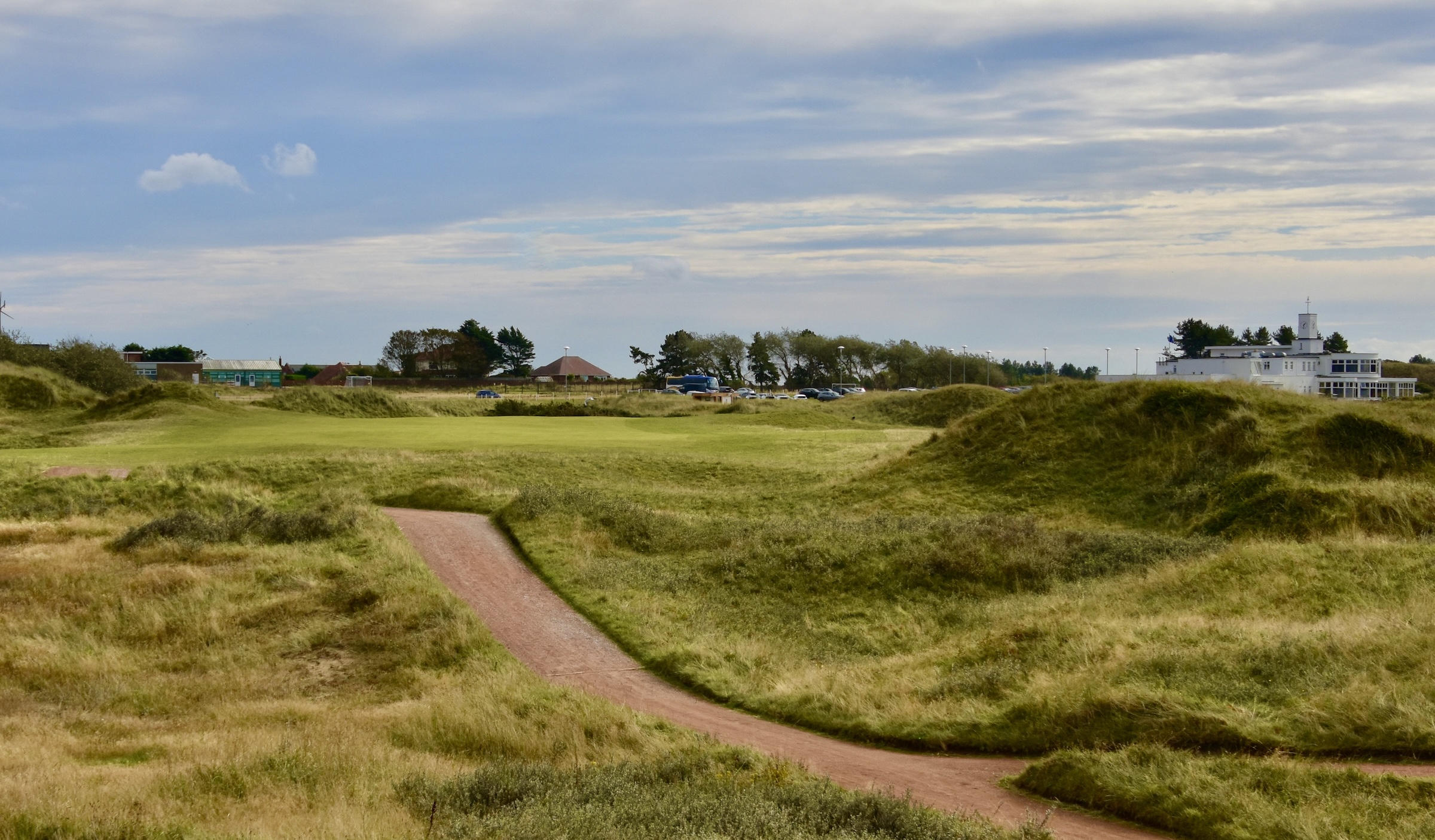
Royal Birkdale is the only one of the five links courses we played on this trip that returns to the clubhouse after the front nine. This time it does it with a dogleg right. There are no bunkers to be wary of from the tee, but once again you are challenged to make a long straight drive to reach the point where you can see the green. I didn’t and this is where I ended up in two.
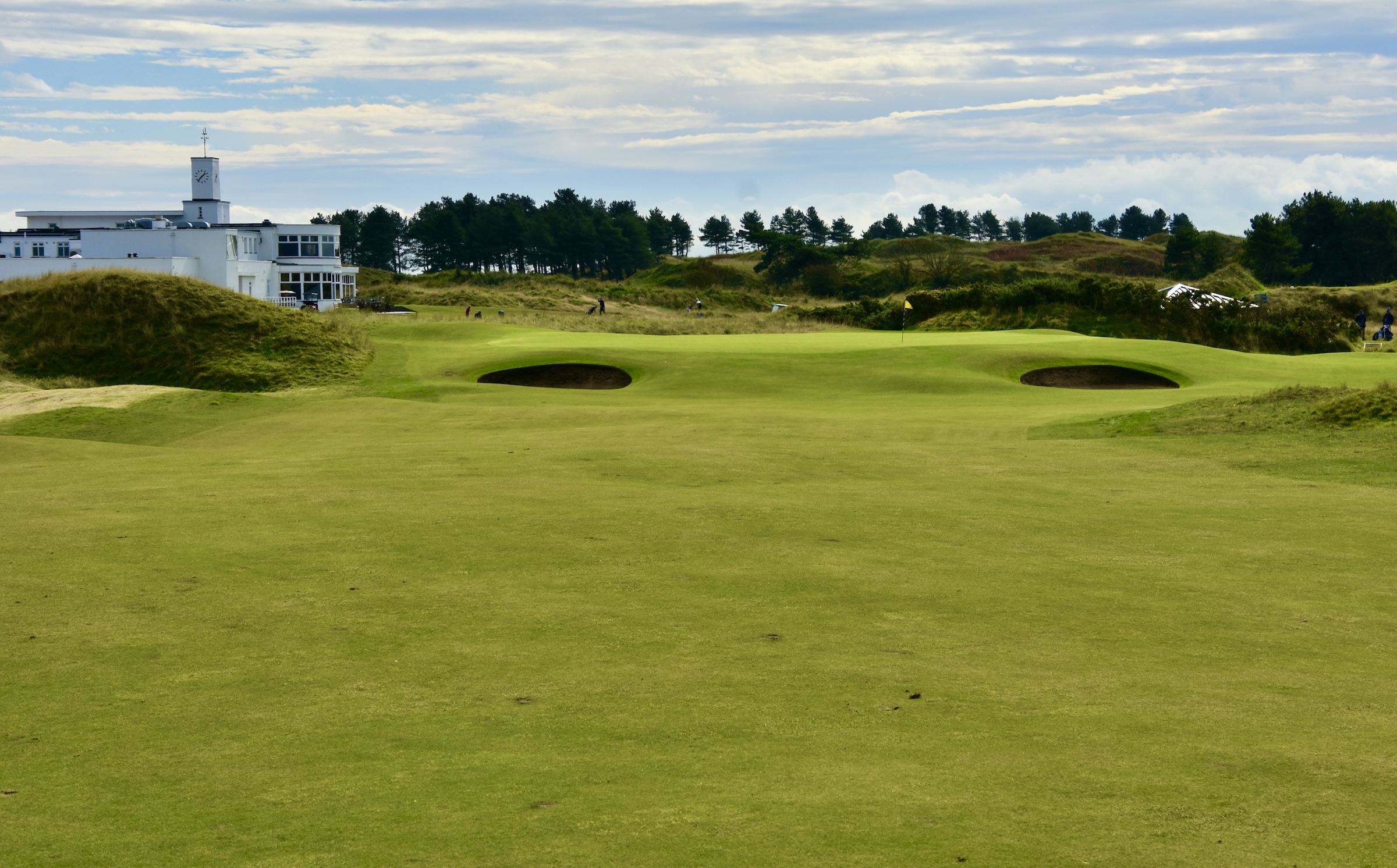
This is a severely crowned green with a large false front so I’m not so badly off trying to stay on it with a wedge in three instead of a wood in two. I said you should be happy starting off this round at Royal Birkdale with a bogey and I’ll say the same about the end of the front nine. It’s only played as a 3,057 yard par 35, but seems much longer and now we have to pay the piper with a 3,240 yard par 37 on the back.
I need a beer or maybe two before facing that.
#10 – 343 Yard Par Four
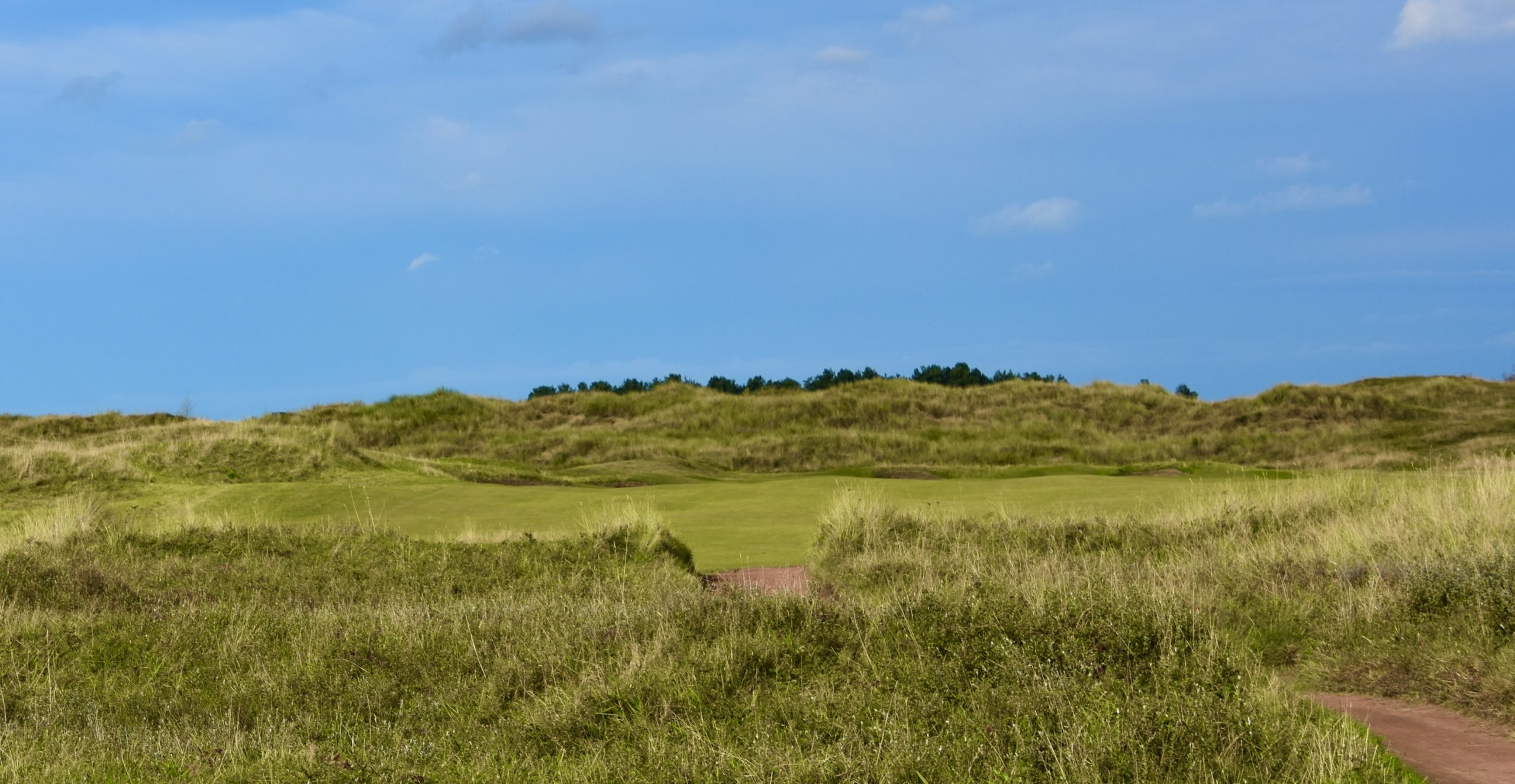
This is probably the most severe dogleg at Royal Birkdale with an almost 90° turn to the left. Fortunately its moderate length and wide fairway make for a relatively easy drive.
That leaves this approach to an elevated green with only one bunker to be avoided. The back is off to a good start with this very parable hole.
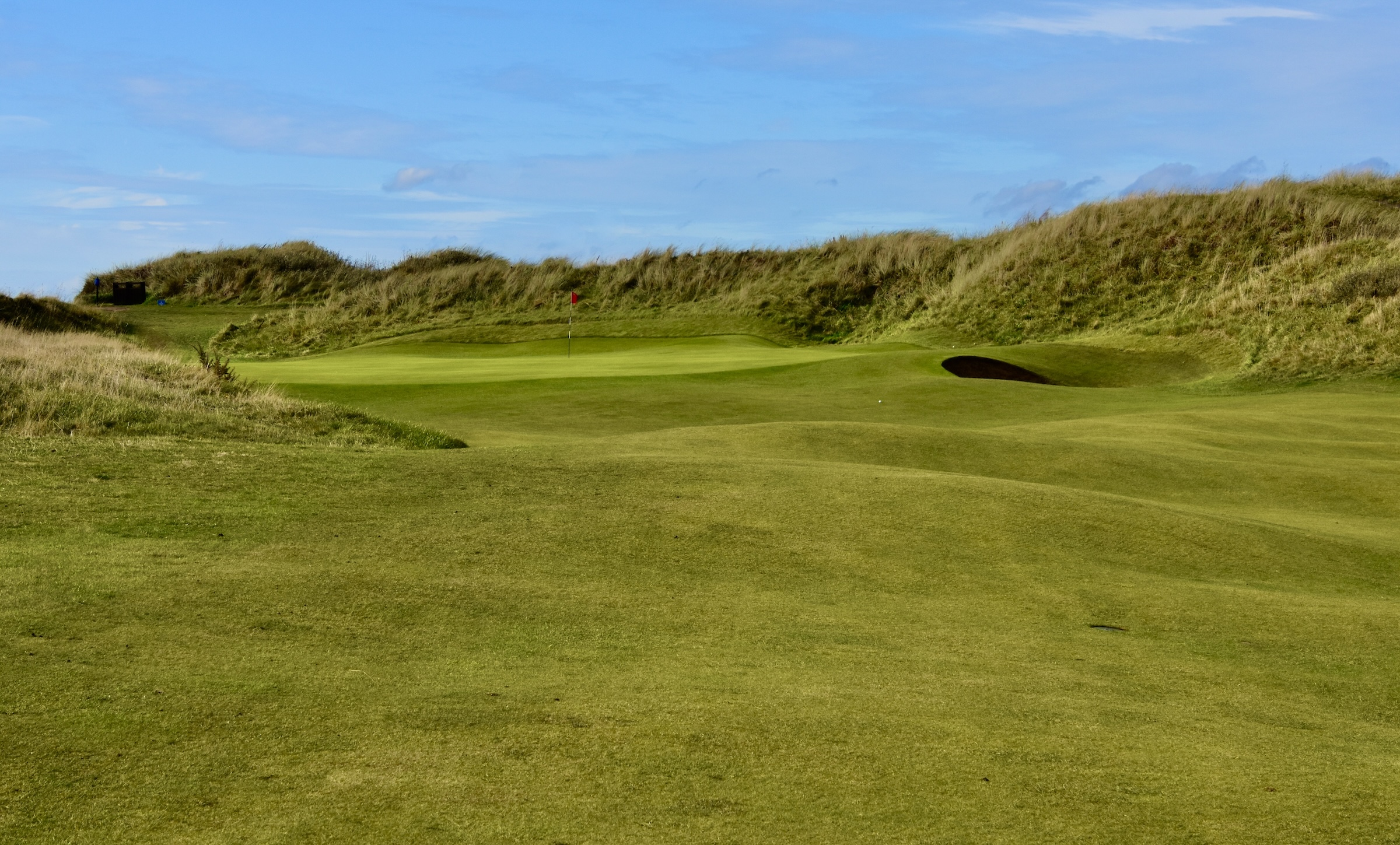
Royal Birkdale #11 – 353 Yard Par Four
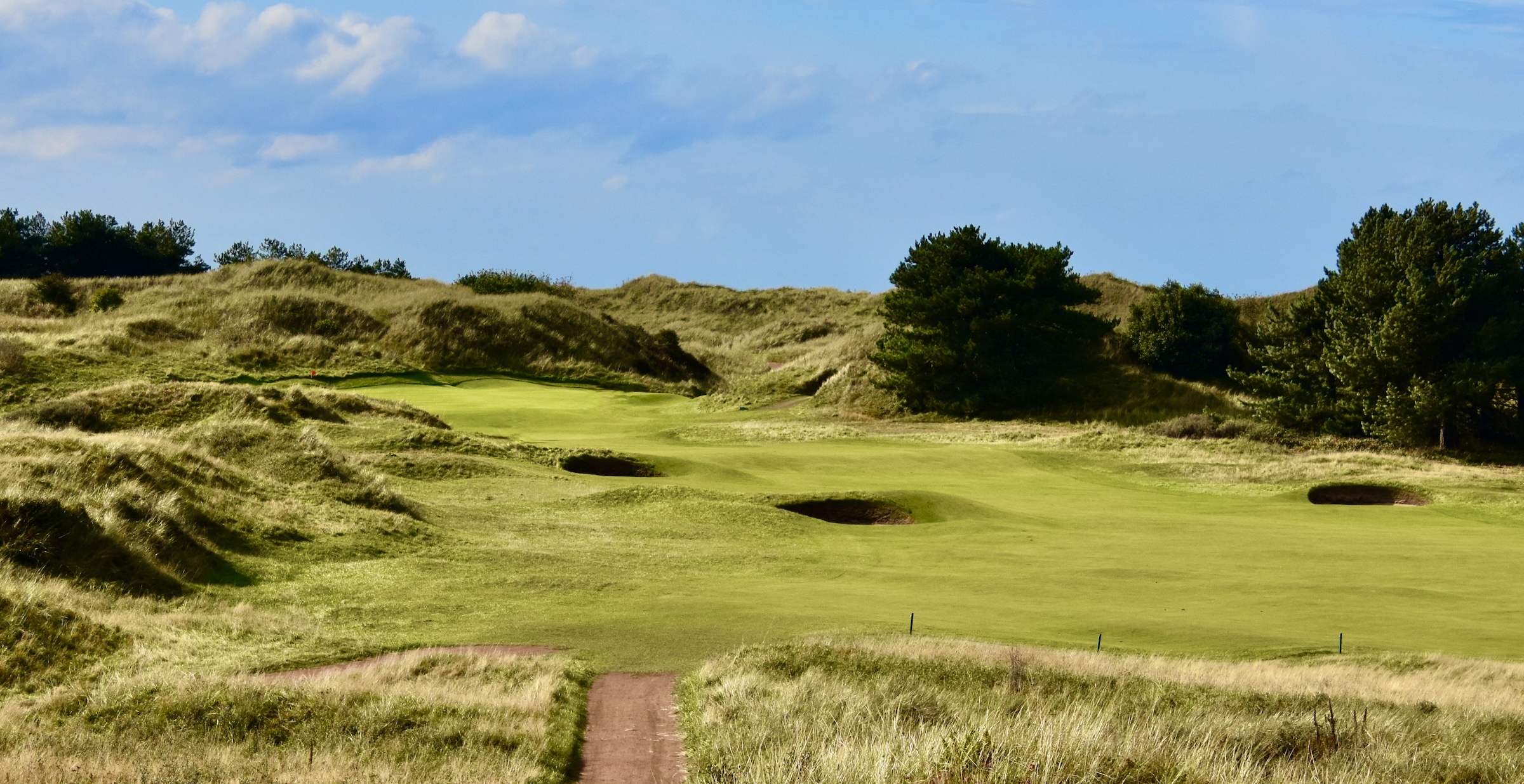
Things get a lot tougher on #11 where there are multiple fairway bunkers to be avoided and a much narrower fairway. While not a true dogleg you almost need to play it like one by staying right off the tee and playing the second shot to the left. If you succeed with your drive the second shot is to probably the largest green at Royal Birkdale with no bunkers to worry about. As with almost every hole on this course, long is not good.
#12 – 160 Yard Par Three
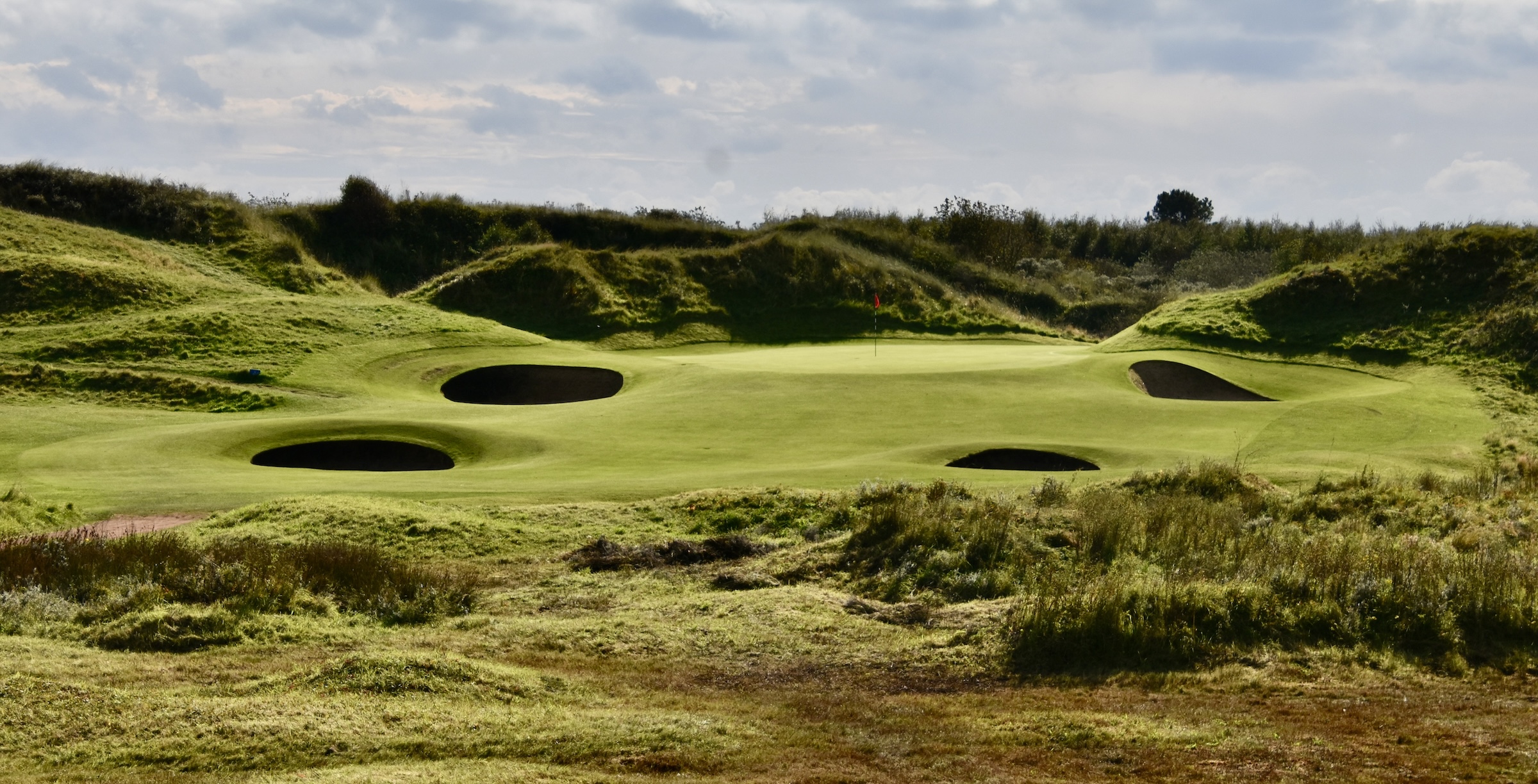
This is a beautiful looking links par three that epitomizes Royal Birkdale. You need to take enough club to reach the green, but not too much or you’ll be facing a very difficult second shot out of the deep rough. This was a situation we all found ourselves in at one point or another on this course. The fortunate thing about today is that the wind has not been much of a factor, except for maybe #3, which makes this tee shot relatively easy.
Ok, so far the back nine has not been the brute I was expecting. Well that is all about to change as we face three par fives in the last six holes and this next par four that plays like a five.
Royal Birkdale #13 – 418 Yard Par Four
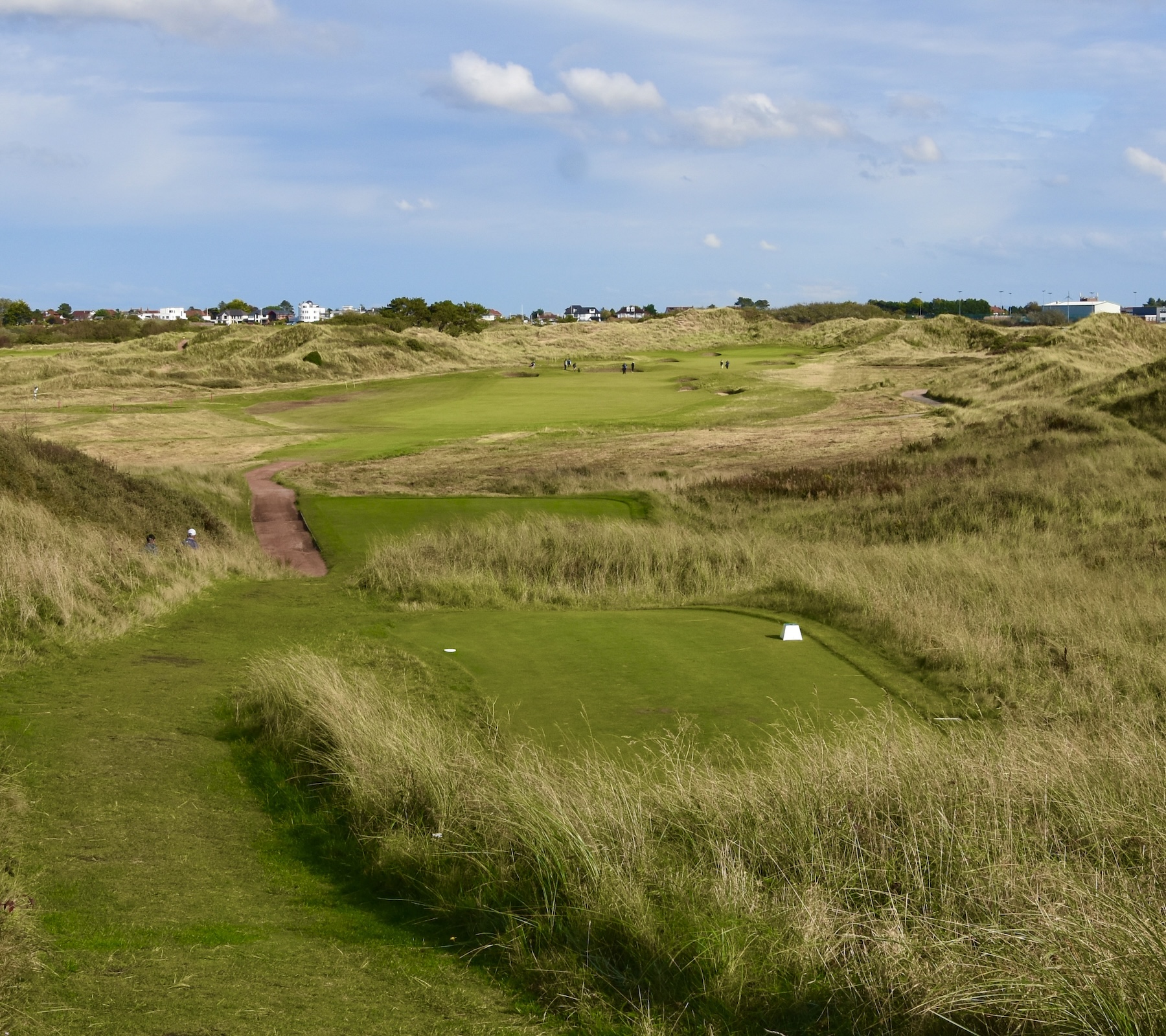
This is the view from the championship tees where this hole plays as a very long par four. Our tees are down below and this is what the average golfer will see from that tee box.
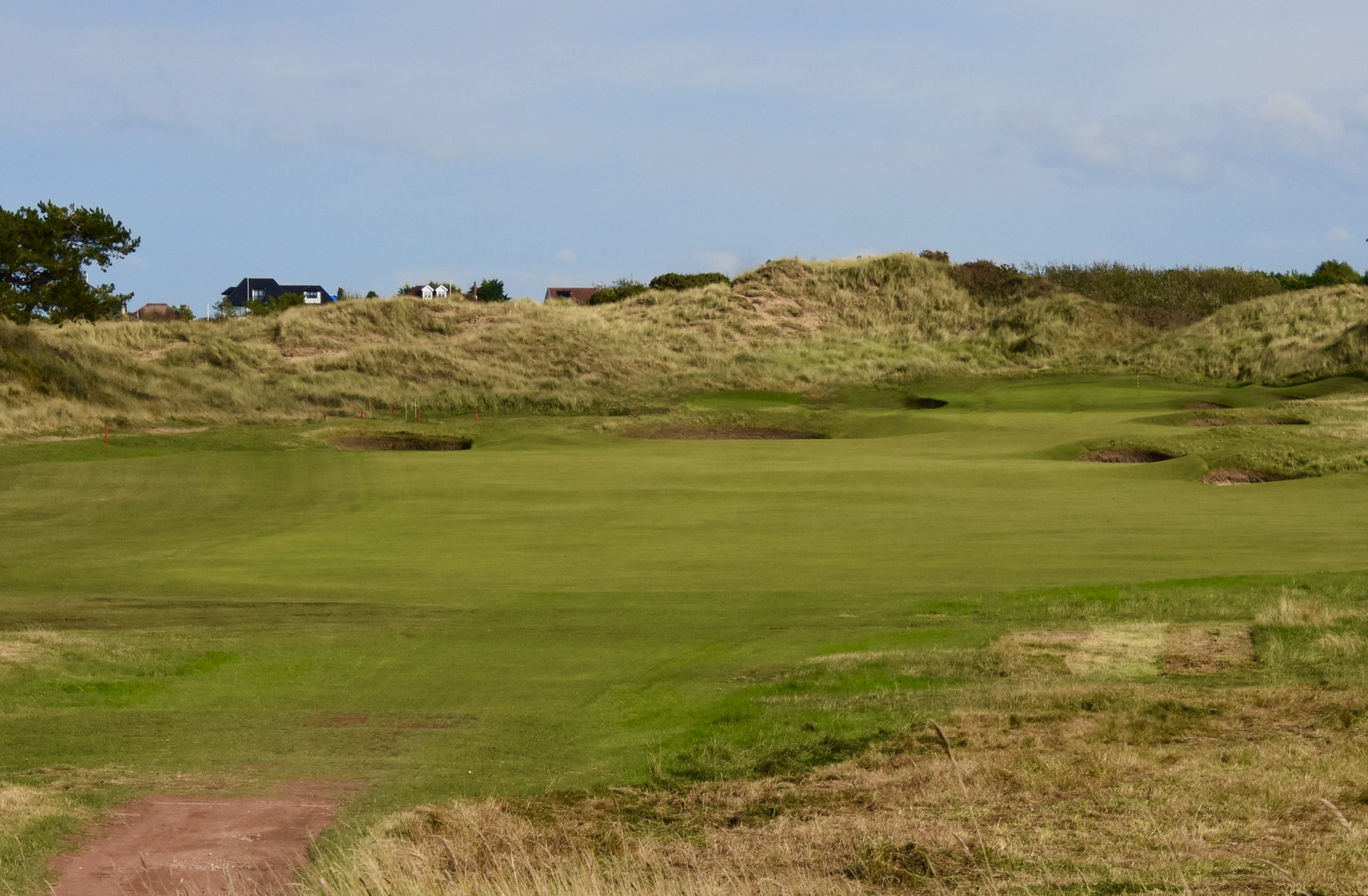
By playing it like a par five you don’t need driver and can maneuver your way down the fairway with a wood and a hybrid leaving this approach shot which is not as far as it looks. That’s a sucker pin placement today. Just hitting to the fat of the green should produce a two putt for bogey which is not to be sneezed at on this hole. This is another hole on which to appreciate the wonderfully groomed fairways at Royal Birkdale and the smooth transition between fairway and green.
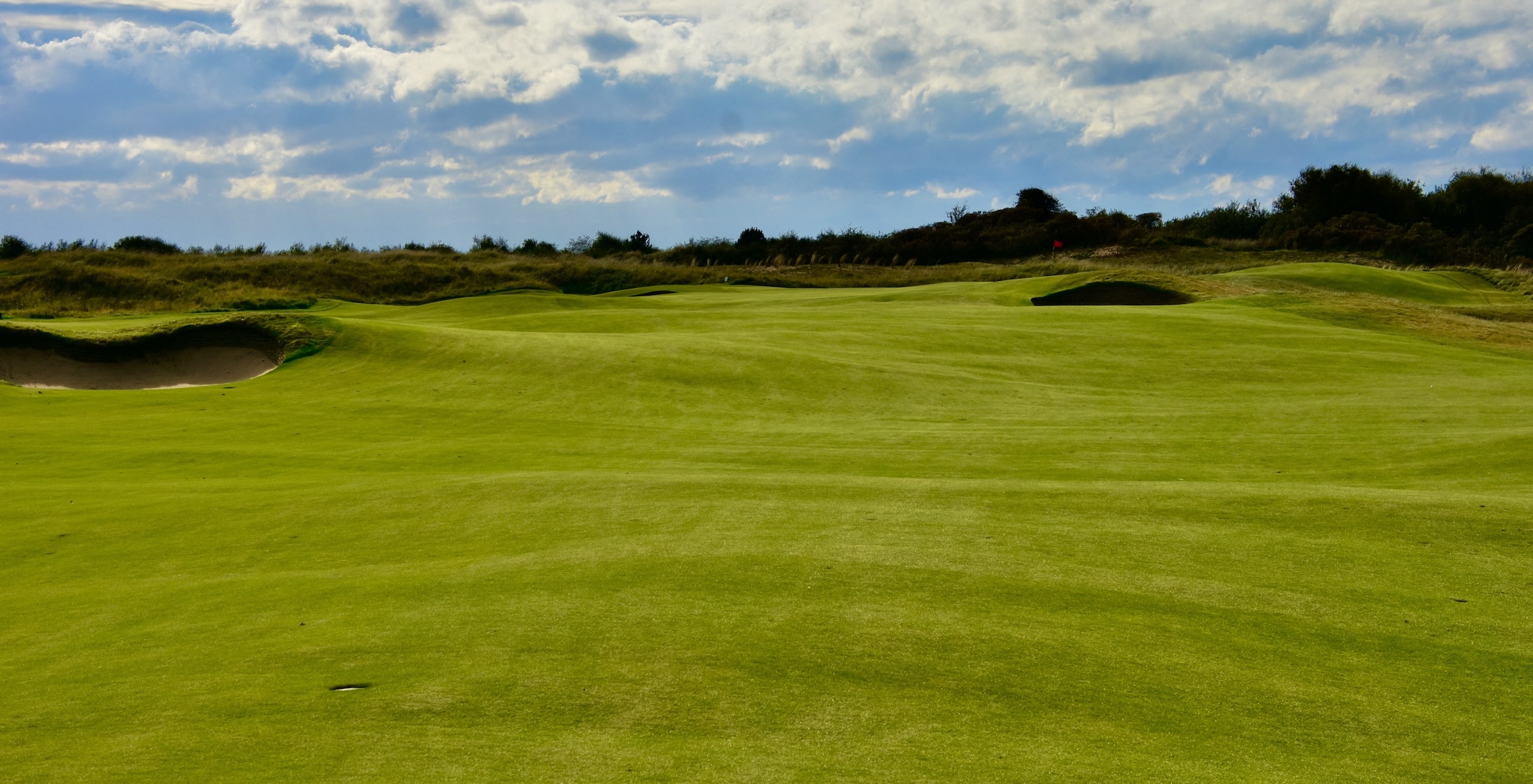
#14 – 516 Yard Par Five

So far so good on the par fives but the level of difficulty ramps up with the #2 stroke hole on the course. The challenge is to avoid the traps on both sides of the fairway from the tee and then to stay well right on the second shot.
You do need two good blows to get to the approach shot to one of the few greens at Royal Birkdale that is not backed by dunes. This hole is a sterling example of a great links par five.
Royal Birkdale #15 – 165 Yard Par Three
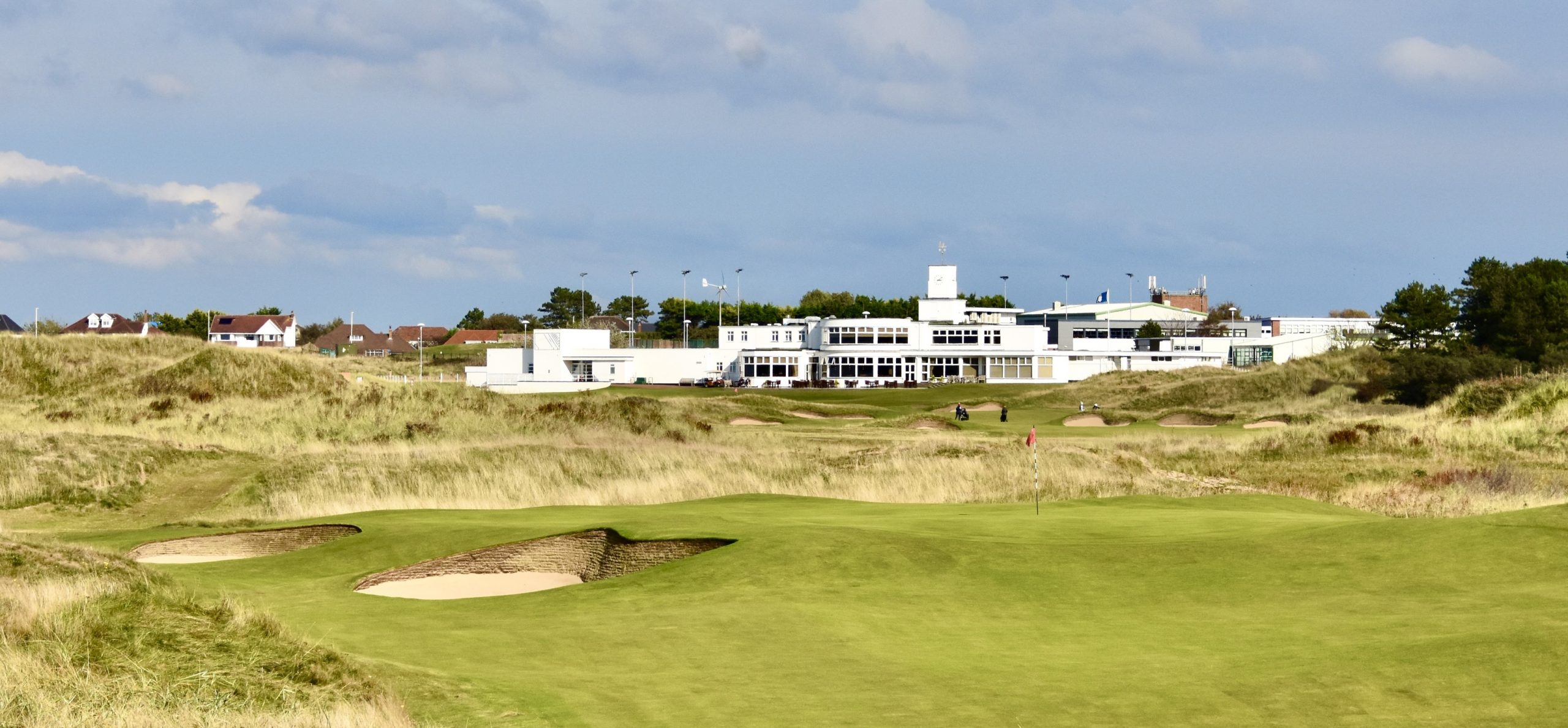
The final par three is the #18 stroke hole with the largest green of the four. Look at the face of that first bunker and you get a good idea of the trouble that awaits you if you find yourself up against it, literally. The saving grace is the total lack of wind and without it one can stay well clear those bunkers. Coming up a bit short is not terrible as you can putt from a fair ways off the green here.
#16 – 317 Yard Par Four
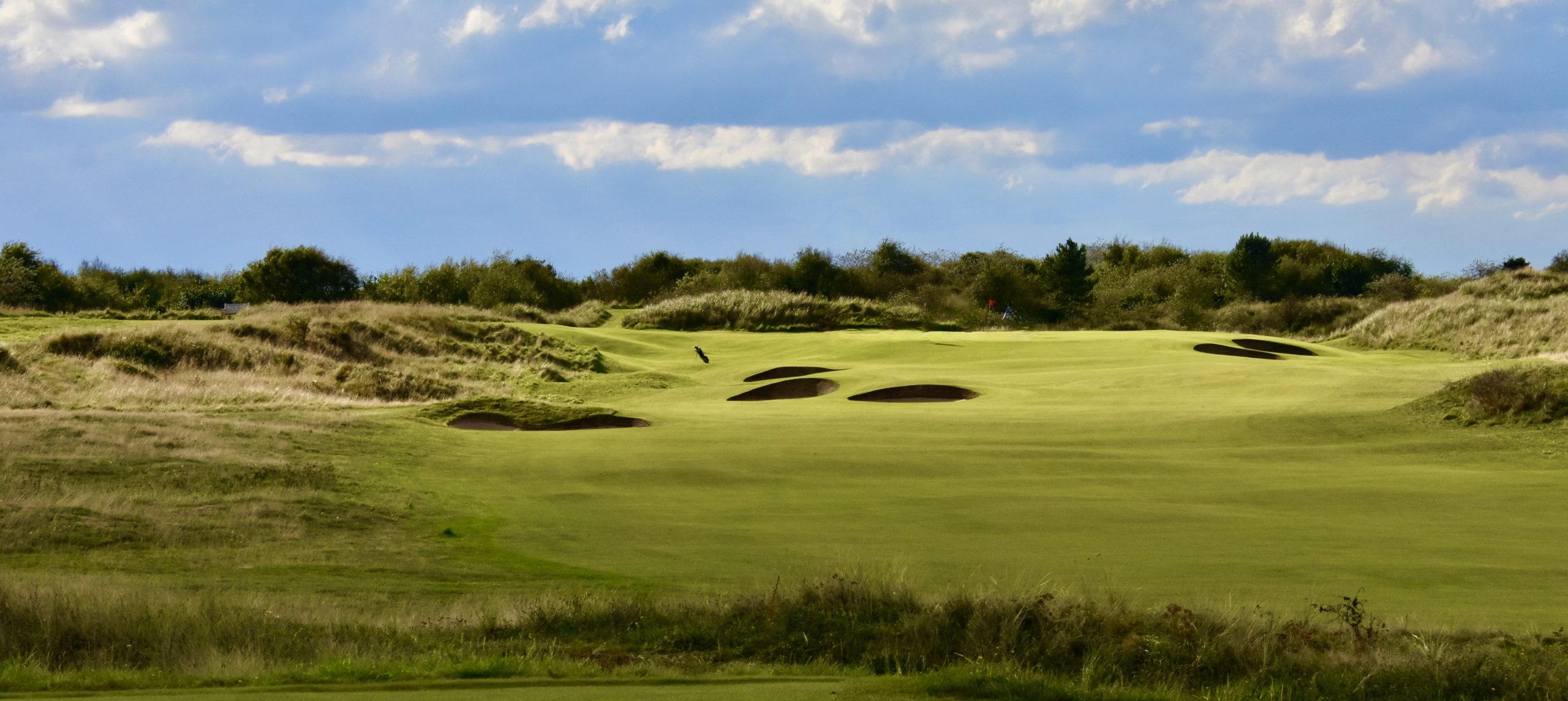
This is the Arnold Palmer hole and that mound on the right is where he found himself in the blackberry patch that has since been removed. Back then it was the 15th. Fortunately, we do not need to tee it up from where Arnie did and a well placed five wood should avoid all the trouble off the tee on this shortest of the par fours at Royal Birkdale.

After visiting the spot from where Arnie made his famous six iron shot, I find this approach left. The green is quite elevated and you can see that two balls have already failed to reach the green. The green is quite large with no real trouble if you go long right so this is one of the few approach shots where you need to take more club than you think and not worry too much about going over.
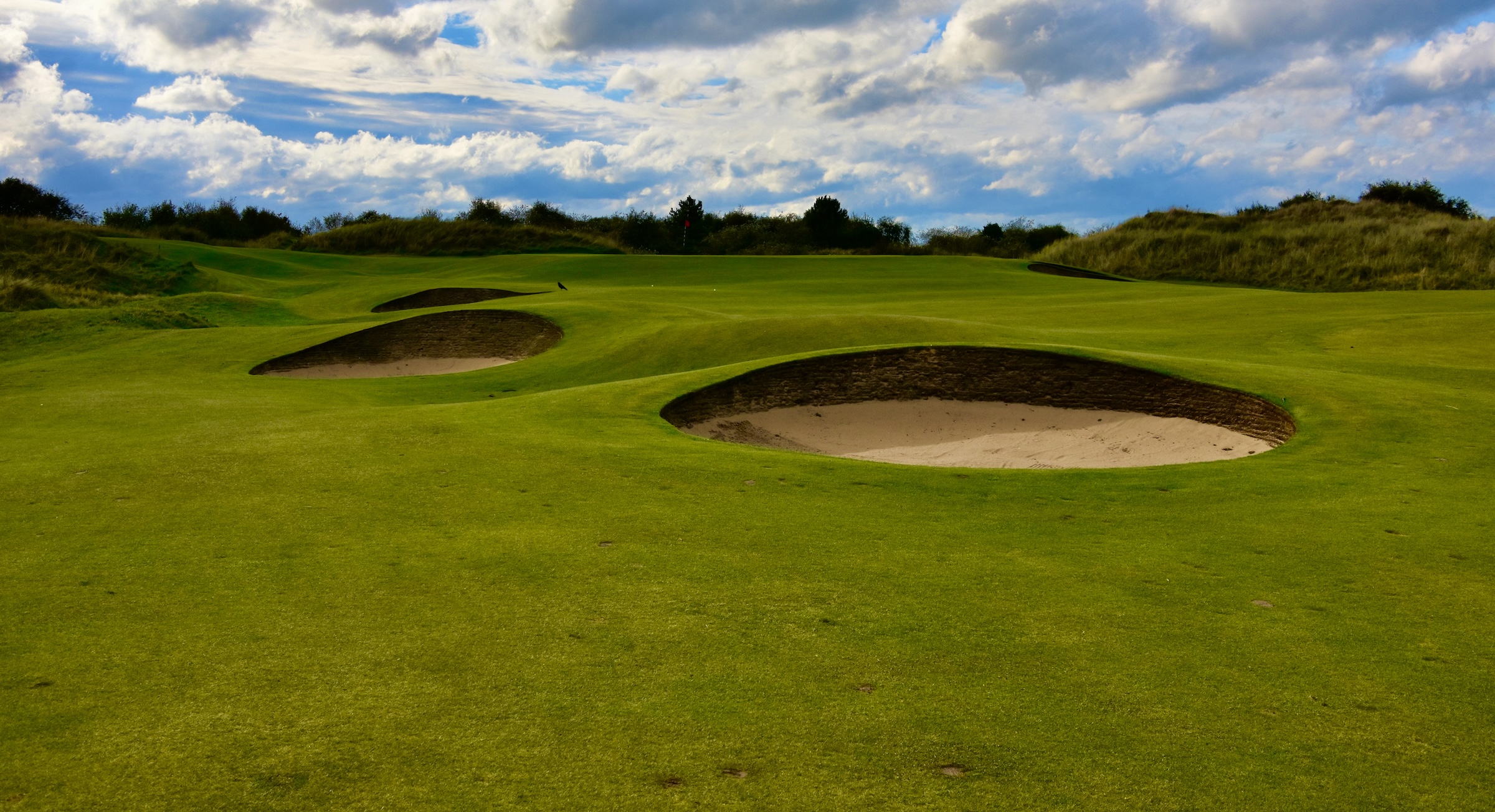
Royal Birkdale #17 – 500 Yard Par Five
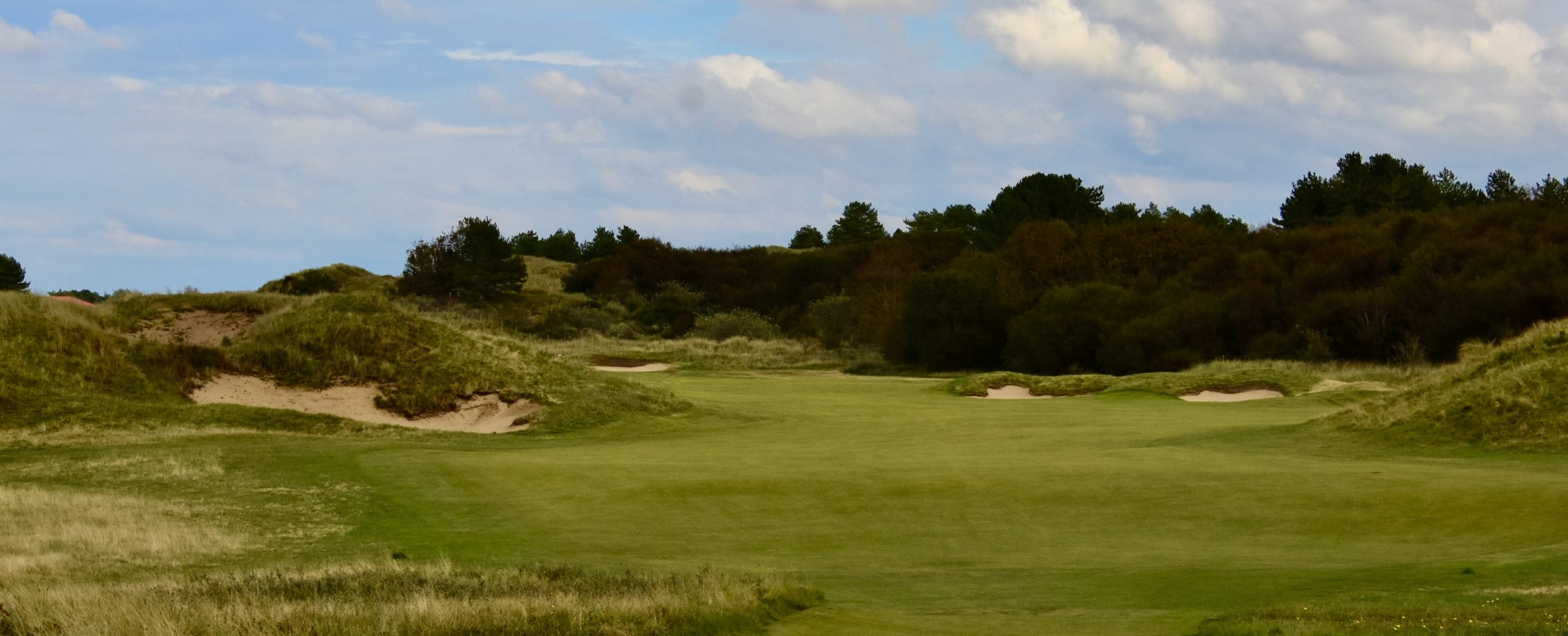
This may be the toughest drive at Royal Birkdale. The fairway is very narrow and like #1, the mound on the left dares you to take it on. The smarter play is to hit something that won’t reach the bunkers on the right and then a wood to this approach. It’s still not an easy third shot by any means, but look at this hole and be thankful you just got a chance to play it. One guy who was thankful was Padraig Harrington who hit a five wood to within a few feet on this hole in 2008 for an eagle that sealed The Open for him a second time.
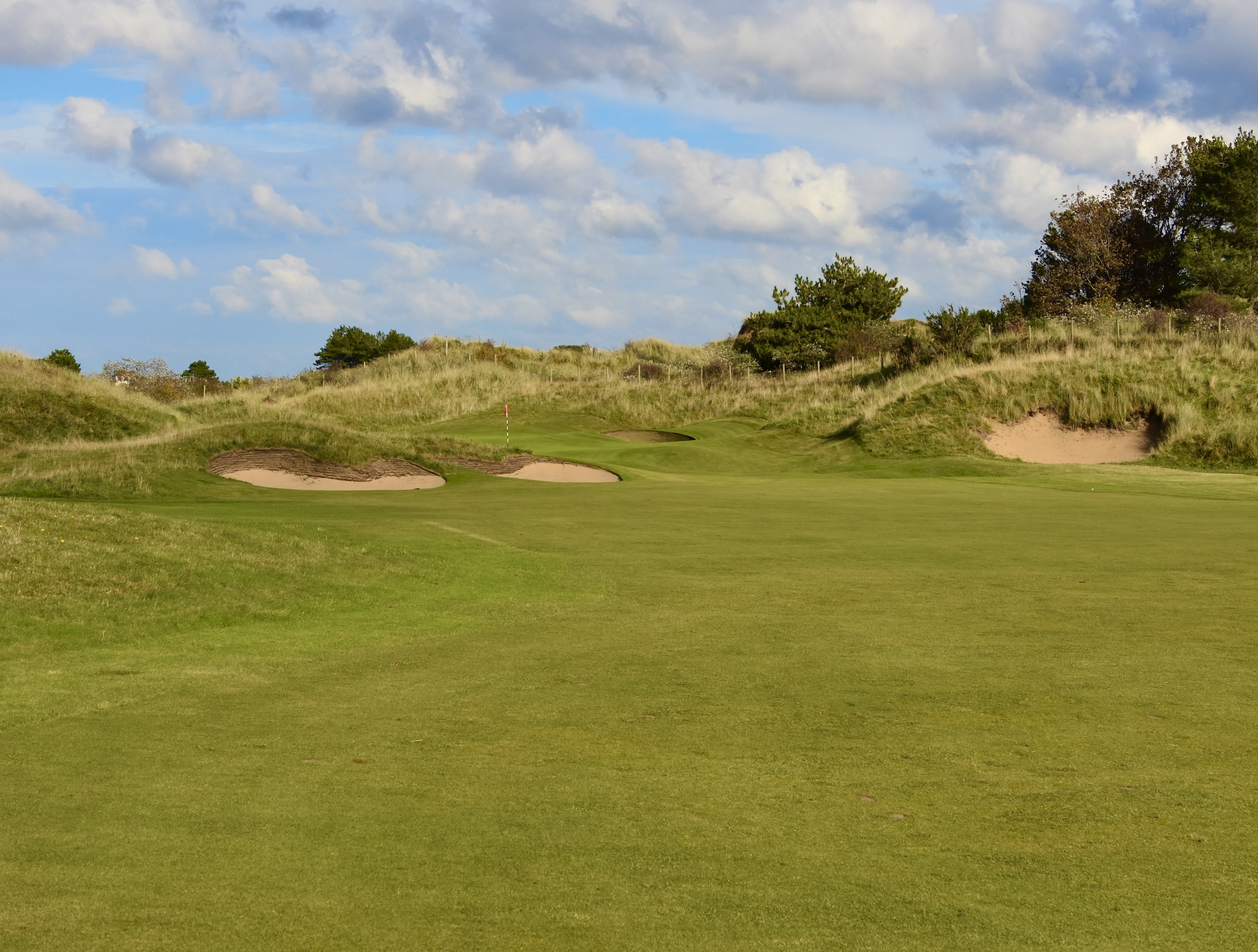
#18 – 468 Yard Five
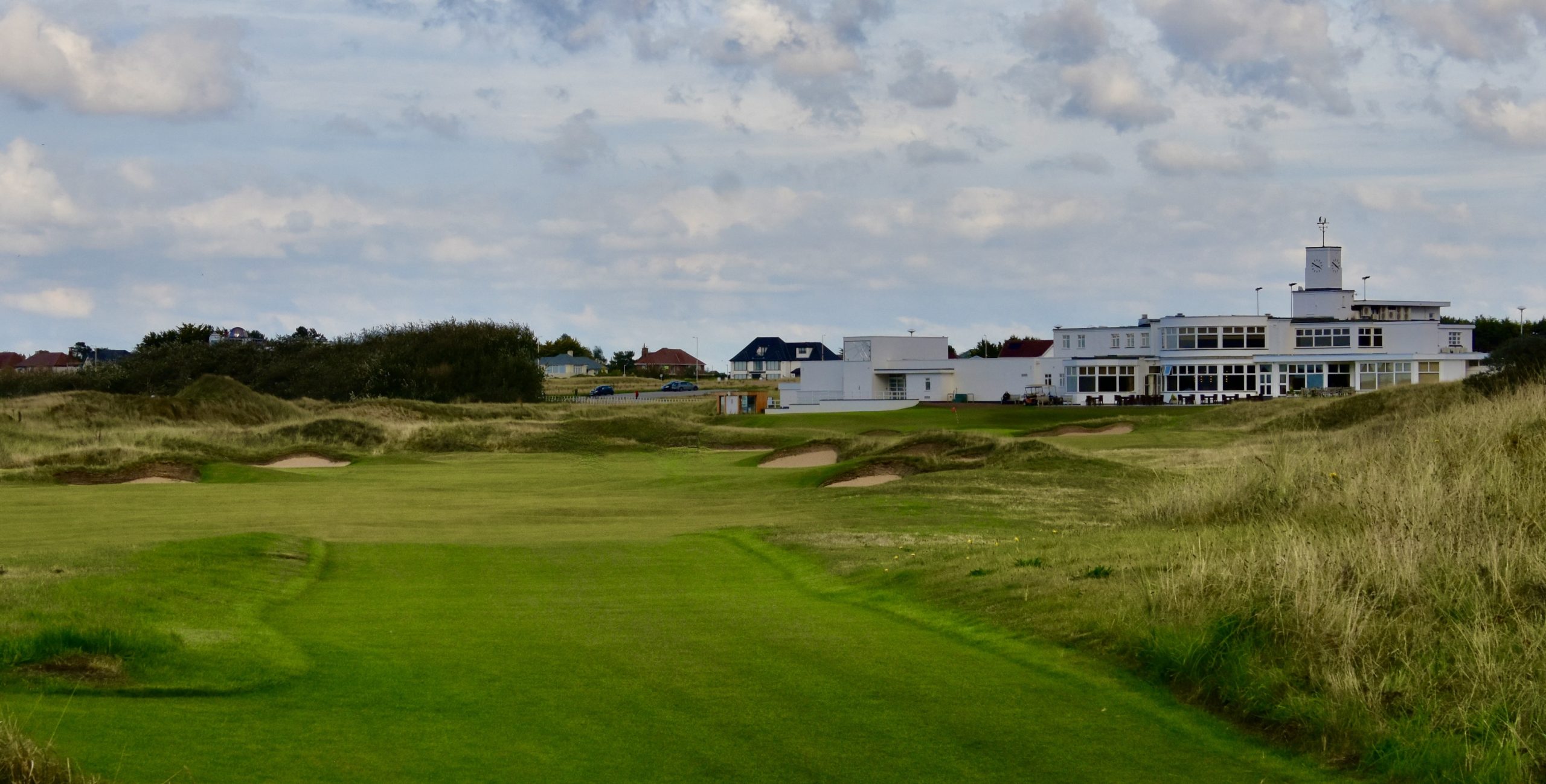
This is a scene to keep in mind when The Open returns here in 2026 as it could well be the determining hole. While the pros play this as a very long and difficult par four we get to play it as we have the other three par fives as a three shot hole. Obviously accuracy off the tee is essential here – there’s even OB on the right. However, two decent shots will leave this type of approach to the green nestled below the iconic clubhouse – a scene you will not forget.
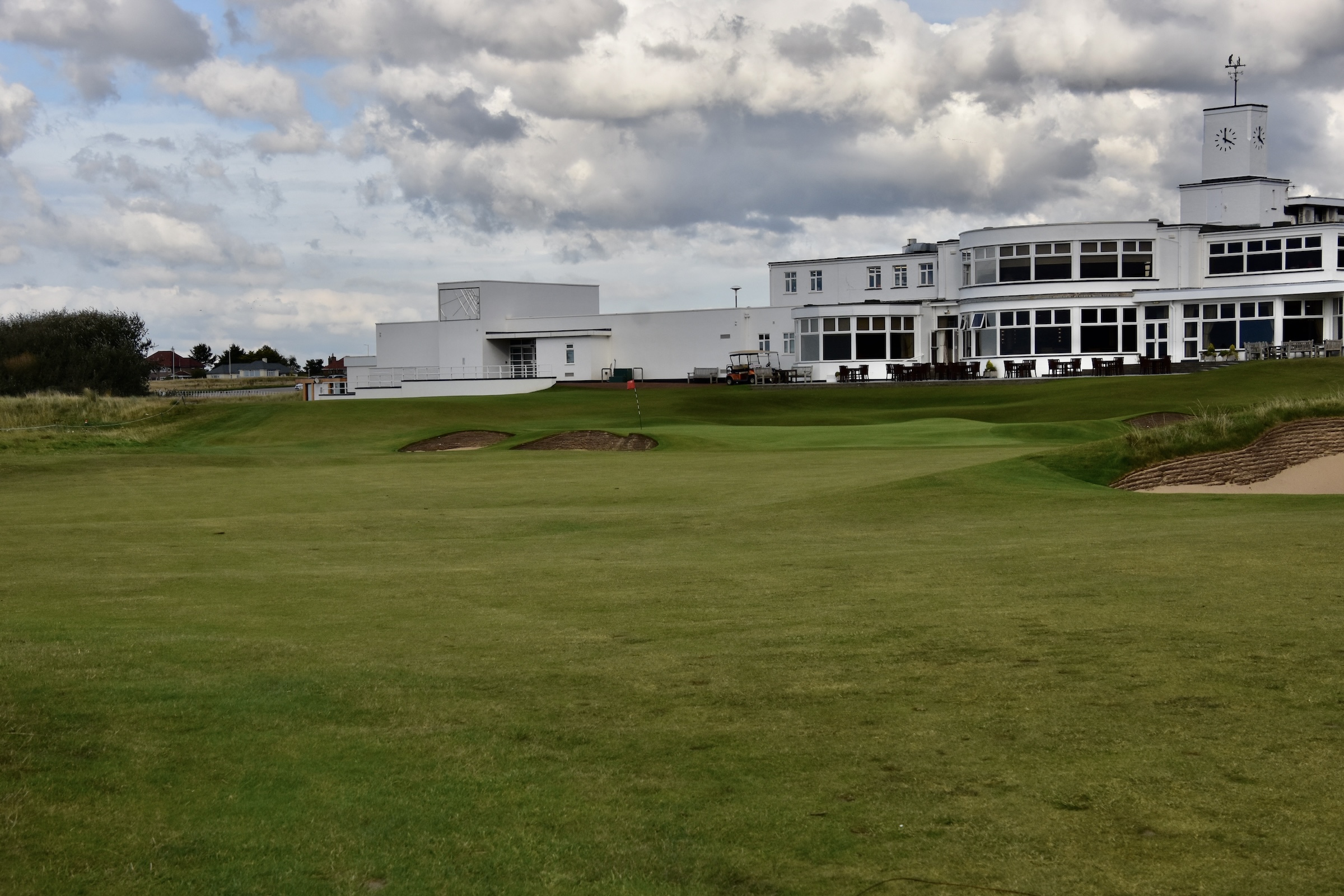
The wind has kindly held off until this last hole and we conclude one the most enjoyable rounds of golf ever on a high note with a final par.
It turns out that those who predicted we would love Royal Birkdale were absolutely right. It is a course to behold and to be played.
Well we have concluded our five courses on England’s Golf Coast and next head to The Belfry for some Ryder Cup parkland golf at the Brabazon course. Hope to see you there.

